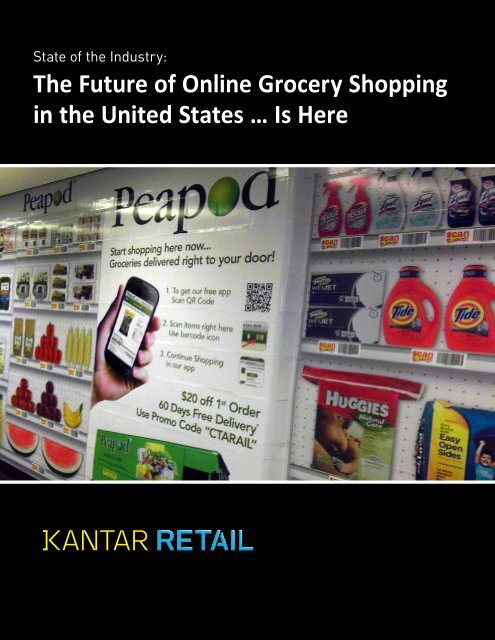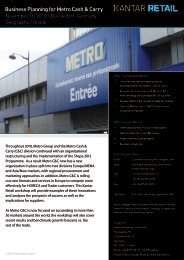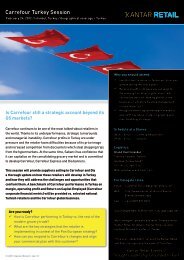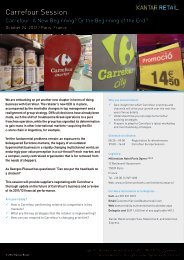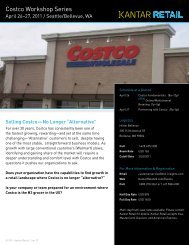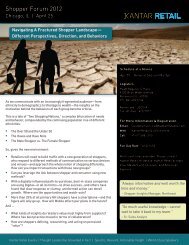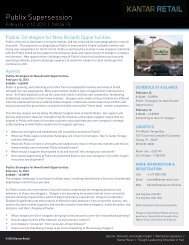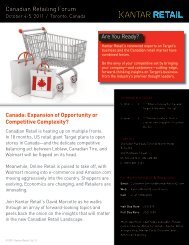The Future of Online Grocery Shopping in the United ... - Kantar Retail
The Future of Online Grocery Shopping in the United ... - Kantar Retail
The Future of Online Grocery Shopping in the United ... - Kantar Retail
You also want an ePaper? Increase the reach of your titles
YUMPU automatically turns print PDFs into web optimized ePapers that Google loves.
State <strong>of</strong> <strong>the</strong> Industry:<br />
<strong>The</strong> <strong>Future</strong> <strong>of</strong> <strong>Onl<strong>in</strong>e</strong> <strong>Grocery</strong> <strong>Shopp<strong>in</strong>g</strong><br />
<strong>in</strong> <strong>the</strong> <strong>United</strong> States … Is Here
Table <strong>of</strong> Contents<br />
/ Authors<br />
Anne Zybowski<br />
Vice President<br />
anne.zybowski@kantarretail.com<br />
Rachel McGuire<br />
Senior Analyst<br />
rachel.mcguire@kantarretail.com<br />
Table <strong>of</strong> Contents<br />
/ <strong>Kantar</strong> <strong>Retail</strong><br />
Suite 1000, 245 First Street, Cambridge, MA 02142 USA<br />
www.kantarretail.com / www.kantarretailiq.com<br />
© 2012 <strong>Kantar</strong> <strong>Retail</strong>. All rights reserved.<br />
© 2012 <strong>Kantar</strong> <strong>Retail</strong><br />
<strong>The</strong> <strong>Future</strong> <strong>of</strong> <strong>Onl<strong>in</strong>e</strong> <strong>Grocery</strong> <strong>Shopp<strong>in</strong>g</strong> <strong>in</strong> <strong>the</strong> <strong>United</strong> States … Is Here<br />
Foreward .....................................................................................................................................................2<br />
HOW BIG: <strong>The</strong> <strong>Onl<strong>in</strong>e</strong> <strong>Grocery</strong> Market <strong>in</strong> <strong>the</strong> <strong>United</strong> States Today ..........................................................3<br />
WHO Shops <strong>Onl<strong>in</strong>e</strong> for Groceries? ............................................................................................................5<br />
WHERE Do Shoppers Shop <strong>Onl<strong>in</strong>e</strong> for Groceries? ...................................................................................7<br />
WHY Buy Groceries <strong>Onl<strong>in</strong>e</strong>? <strong>The</strong> Shopper Perspective ............................................................................9<br />
WHY NOT Shop <strong>Onl<strong>in</strong>e</strong>? Barriers to <strong>the</strong> Growth <strong>of</strong> <strong>Onl<strong>in</strong>e</strong> <strong>Grocery</strong> .......................................................18<br />
LOOKING FORWARD: Where Do We Go From Here? .............................................................................21<br />
No part <strong>of</strong> this work may be reproduced or transmitted <strong>in</strong> any form or by any means, electronic or mechanical,<br />
<strong>in</strong>clud<strong>in</strong>g photocopy<strong>in</strong>g, record<strong>in</strong>g, or by any <strong>in</strong>formation storage and/or retrieval system, without permission <strong>in</strong><br />
writ<strong>in</strong>g from <strong>the</strong> publisher.<br />
- 1 -<br />
/ Contributors<br />
Mary Brett Whitfield<br />
Senior Vice President<br />
marybrett.whitfield@kantarretail.com<br />
Debra Miller Arebesman<br />
Senior Associate, <strong>Retail</strong> & Consumer Products<br />
darbesman@compete.com
Foreward<br />
© 2012 <strong>Kantar</strong> <strong>Retail</strong><br />
<strong>The</strong> <strong>Future</strong> <strong>of</strong> <strong>Onl<strong>in</strong>e</strong> <strong>Grocery</strong> <strong>Shopp<strong>in</strong>g</strong> <strong>in</strong> <strong>the</strong> <strong>United</strong> States … Is Here<br />
<strong>The</strong> notion <strong>of</strong> onl<strong>in</strong>e grocery shopp<strong>in</strong>g break<strong>in</strong>g <strong>in</strong>to <strong>the</strong> ma<strong>in</strong>stream is highly refuted across <strong>the</strong> <strong>in</strong>dustry, with<br />
many <strong>in</strong>sist<strong>in</strong>g that it will never be successful <strong>in</strong> <strong>the</strong> <strong>United</strong> States outside <strong>of</strong> a few cities with high population<br />
density such as New York and San Francisco. Yes, <strong>the</strong>re are some regional or new delivery players <strong>in</strong> select<br />
markets that are test<strong>in</strong>g onl<strong>in</strong>e grocery models, but naysayers claim it is not susta<strong>in</strong>able and will never be<br />
pr<strong>of</strong>itable. Contrary to conventional wisdom, <strong>Kantar</strong> <strong>Retail</strong> is predict<strong>in</strong>g that U.S. onl<strong>in</strong>e grocery shopp<strong>in</strong>g is<br />
about to explode—and it’s not a matter <strong>of</strong> “IF,” it’s a question <strong>of</strong> “WHEN.”<br />
Contrary to conventional wisdom, <strong>Kantar</strong> <strong>Retail</strong><br />
is predict<strong>in</strong>g that U.S. onl<strong>in</strong>e grocery shopp<strong>in</strong>g is<br />
about to explode—and it’s not a matter <strong>of</strong> “IF,” it’s a<br />
question <strong>of</strong> “WHEN.”<br />
As <strong>Kantar</strong> <strong>Retail</strong> looks across <strong>the</strong> global landscape, onl<strong>in</strong>e grocery shopp<strong>in</strong>g is evolv<strong>in</strong>g dramatically <strong>in</strong> <strong>the</strong><br />
form <strong>of</strong> home delivery and o<strong>the</strong>r “click & collect” models—with <strong>the</strong> UK and France lead<strong>in</strong>g <strong>the</strong> way. Certa<strong>in</strong>ly<br />
<strong>the</strong>re are many differences <strong>in</strong> <strong>the</strong> evolution <strong>of</strong> onl<strong>in</strong>e shopp<strong>in</strong>g <strong>in</strong> general as well as retail market development<br />
across <strong>the</strong>se three markets, but <strong>the</strong> fact rema<strong>in</strong>s that onl<strong>in</strong>e grocery shopp<strong>in</strong>g is grow<strong>in</strong>g quickly across <strong>the</strong><br />
board—especially as retailers figure out ways to deliver convenience to grocery shoppers without necessarily<br />
<strong>in</strong>curr<strong>in</strong>g <strong>the</strong> cost <strong>of</strong> <strong>the</strong> last mile associated with home delivery. Innovation <strong>in</strong> click & collect models promises<br />
to accelerate <strong>the</strong> growth <strong>of</strong> onl<strong>in</strong>e grocery <strong>in</strong> all three markets. Yes, even <strong>in</strong> <strong>the</strong> <strong>United</strong> States.<br />
To support our hypo<strong>the</strong>sis, <strong>Kantar</strong> <strong>Retail</strong> partnered with Compete (a <strong>Kantar</strong> Media company) to delve <strong>in</strong>to<br />
<strong>the</strong> state <strong>of</strong> onl<strong>in</strong>e grocery shopp<strong>in</strong>g <strong>in</strong> each market today by gett<strong>in</strong>g a read on why and how shoppers buy<br />
groceries onl<strong>in</strong>e—as well as understand what <strong>the</strong> barriers are for those who don’t shop onl<strong>in</strong>e today for<br />
groceries.<br />
Understand<strong>in</strong>g <strong>the</strong> state <strong>of</strong> <strong>the</strong> market today and <strong>the</strong> <strong>in</strong>sights conta<strong>in</strong>ed <strong>in</strong> this report are critical for retailers<br />
and manufacturers alike to prepare for <strong>the</strong> future, today.<br />
Innovation <strong>in</strong> click & collect models promises to<br />
accelerate <strong>the</strong> growth <strong>of</strong> onl<strong>in</strong>e grocery.<br />
- 2 -
© 2012 <strong>Kantar</strong> <strong>Retail</strong><br />
HOW BIG: <strong>The</strong> <strong>Onl<strong>in</strong>e</strong> <strong>Grocery</strong><br />
Market <strong>in</strong> <strong>the</strong> <strong>United</strong> States Today<br />
Much <strong>of</strong> <strong>the</strong> skepticism about <strong>the</strong> future <strong>of</strong> onl<strong>in</strong>e grocery stems from <strong>the</strong> low penetration levels today. While<br />
total onl<strong>in</strong>e sales accounted for 7% <strong>of</strong> total U.S. retail sales <strong>in</strong> 2011, category penetration varies widely. <strong>Onl<strong>in</strong>e</strong><br />
penetration <strong>in</strong> music, videos, and electronics sales is over 20%, yet onl<strong>in</strong>e grocery accounts for less than 1%<br />
<strong>of</strong> total grocery sales today. But <strong>Kantar</strong> <strong>Retail</strong> forecasts that by 2020 onl<strong>in</strong>e penetration <strong>of</strong> grocery sales will<br />
more than quadruple and represent nearly USD50 billion <strong>in</strong> sales (Figure 1).<br />
21%<br />
32%<br />
27%<br />
Computer hardware<br />
36%<br />
12%<br />
18%<br />
21%<br />
Office equipment &<br />
supplies<br />
30%<br />
4%<br />
9%<br />
24%<br />
Music & videos<br />
45%<br />
2%<br />
9%<br />
18%<br />
Electronics & appliances<br />
31%<br />
3%<br />
7%<br />
15%<br />
Sport<strong>in</strong>g goods<br />
Source: U.S. Department <strong>of</strong> Commerce and <strong>Kantar</strong> <strong>Retail</strong><br />
Figure 1: <strong>Onl<strong>in</strong>e</strong> Share <strong>of</strong> Total Category Spend<strong>in</strong>g<br />
25%<br />
11%<br />
6%<br />
10%<br />
Computer s<strong>of</strong>tware<br />
21%<br />
3%<br />
6%<br />
- 3 -<br />
10%<br />
Books & magaz<strong>in</strong>es<br />
33%<br />
4%<br />
7%<br />
11%<br />
Toys, hobby goods, &<br />
games<br />
20%<br />
2%<br />
5%<br />
10%<br />
Cloth<strong>in</strong>g & cloth<strong>in</strong>g<br />
accessories<br />
20%<br />
2%<br />
7%<br />
8%<br />
Autos<br />
15%<br />
1%<br />
4%<br />
7%<br />
Furniture & home<br />
furnish<strong>in</strong>gs<br />
15%<br />
2002<br />
2007<br />
2012E<br />
2020F<br />
1%<br />
1%<br />
2%<br />
6%<br />
0%<br />
1%<br />
1%<br />
4%<br />
<strong>Kantar</strong> <strong>Retail</strong> forecasts that by 2020 onl<strong>in</strong>e penetration<br />
<strong>of</strong> grocery sales will more than quadruple and<br />
represent nearly USD50 billion <strong>in</strong> sales.<br />
Drugs, health & beauty<br />
aids<br />
Food, beer, & w<strong>in</strong>e
Despite <strong>the</strong> limited penetration <strong>of</strong> onl<strong>in</strong>e grocery sales, onl<strong>in</strong>e shopp<strong>in</strong>g habits are “sticky” among shoppers<br />
who already shop onl<strong>in</strong>e: 11% <strong>of</strong> <strong>the</strong>se shoppers have purchased groceries onl<strong>in</strong>e (Figure 2).<br />
27%<br />
Books *<br />
49%<br />
30%<br />
Media#<br />
© 2012 <strong>Kantar</strong> <strong>Retail</strong><br />
42%<br />
65%<br />
Apparel<br />
35%<br />
29%<br />
30%<br />
Electronics<br />
Figure 2: Categories Purchased <strong>in</strong> Last 3 Months: In-Store vs. <strong>Onl<strong>in</strong>e</strong><br />
47%<br />
*Physical and electronic; #Movies, music, and video games<br />
**Paper products, cleaners, laundry supplies, etc.<br />
***Includ<strong>in</strong>g furniture<br />
Source: Compete <strong>Onl<strong>in</strong>e</strong> Intelligence Study, Spr<strong>in</strong>g 2012; <strong>Kantar</strong> <strong>Retail</strong> analysis<br />
26%<br />
Shoes<br />
70%<br />
25%<br />
Health & beauty<br />
products<br />
49%<br />
16%<br />
Office & school supplies<br />
28%<br />
HOW BIG: <strong>The</strong> <strong>Onl<strong>in</strong>e</strong> <strong>Grocery</strong> Market <strong>in</strong> <strong>the</strong> <strong>United</strong> States Today<br />
In-Store <strong>Onl<strong>in</strong>e</strong><br />
Baby, children & toys<br />
15%<br />
22%<br />
Jewelry & accessories<br />
- 4 -<br />
15%<br />
31%<br />
13%<br />
Kitchenware & HH<br />
appliances<br />
50%<br />
Pet supplies<br />
12%<br />
91%<br />
Groceries<br />
11%<br />
21%<br />
Sport<strong>in</strong>g goods<br />
11%<br />
82%<br />
10%<br />
HH essentials **<br />
39%<br />
HI products & tools<br />
9%<br />
22%<br />
Home furnish<strong>in</strong>gs ***<br />
8%<br />
43%<br />
Garden supplies<br />
7%
© 2012 <strong>Kantar</strong> <strong>Retail</strong><br />
WHO Shops <strong>Onl<strong>in</strong>e</strong> for Groceries?<br />
As a first step <strong>in</strong> understand<strong>in</strong>g onl<strong>in</strong>e grocery shopp<strong>in</strong>g behavior and where it might be headed, it is<br />
worthwhile to take a closer look at <strong>the</strong> 11% <strong>of</strong> shoppers who say <strong>the</strong>y are already buy<strong>in</strong>g at least some <strong>of</strong> <strong>the</strong>ir<br />
groceries onl<strong>in</strong>e. <strong>The</strong>re are some key demographic differences between onl<strong>in</strong>e and <strong>in</strong>-store grocery shoppers<br />
but also a few areas where one might be surprised to see essentially no difference. <strong>The</strong>se differences (and<br />
lack <strong>the</strong>re<strong>of</strong>) suggest that onl<strong>in</strong>e grocery shopp<strong>in</strong>g is already a part <strong>of</strong> <strong>the</strong> shopp<strong>in</strong>g rout<strong>in</strong>e for households<br />
across a wide range <strong>of</strong> needs (Figure 3).<br />
<strong>Onl<strong>in</strong>e</strong> grocery shoppers are significantly more likely than <strong>the</strong>ir <strong>in</strong>-store counterparts to be male and<br />
young. In particular, onl<strong>in</strong>e grocery shoppers are more likely to be younger Gen X or older Gen Y. As Gen<br />
Y shoppers cont<strong>in</strong>ue to enter <strong>the</strong> household formation life stage and establish shopp<strong>in</strong>g rout<strong>in</strong>es, shopp<strong>in</strong>g<br />
onl<strong>in</strong>e for a whole range <strong>of</strong> products—<strong>in</strong>clud<strong>in</strong>g groceries—is likely to be a cornerstone <strong>of</strong> those rout<strong>in</strong>es.<br />
<strong>The</strong> <strong>in</strong>come differences <strong>of</strong> <strong>in</strong>-store vs. onl<strong>in</strong>e grocery shoppers are not as pronounced as one might th<strong>in</strong>k.<br />
In fact, shoppers at both <strong>the</strong> very low and very high ends <strong>of</strong> <strong>the</strong> <strong>in</strong>come spectrum are more likely to buy<br />
groceries onl<strong>in</strong>e.<br />
<strong>The</strong>re is virtually no difference between onl<strong>in</strong>e vs. <strong>in</strong>-store shoppers <strong>in</strong> terms <strong>of</strong> how likely <strong>the</strong>y are to have<br />
children liv<strong>in</strong>g at home. And perhaps most surpris<strong>in</strong>gly, <strong>the</strong> percent <strong>of</strong> onl<strong>in</strong>e and <strong>in</strong>-store shoppers who<br />
fall <strong>in</strong>to <strong>the</strong> 65+ age group is nearly identical.<br />
Figure 3: WHO Shops <strong>Onl<strong>in</strong>e</strong> for Groceries—<strong>The</strong> 11%: Affluent, Male, Gen Y<br />
48%<br />
57%<br />
52%<br />
43%<br />
41%<br />
33%<br />
2% 3%<br />
22% 21% 20% 16% 13% 9% 10% 10%<br />
Male Female 18-24 25-34 35-44 45-54 55-64 65+<br />
33%<br />
34%<br />
66%<br />
65%<br />
Children <strong>in</strong> HH No children <strong>in</strong><br />
HH<br />
32%<br />
Note: Arrows <strong>in</strong>dicate significant difference between <strong>in</strong>-store and onl<strong>in</strong>e grocery purchasers (90% confidence level)<br />
Source: Compete <strong>Onl<strong>in</strong>e</strong> Intelligence Survey, Spr<strong>in</strong>g 2012; <strong>Kantar</strong> <strong>Retail</strong> analysis<br />
36%<br />
- 5 -<br />
27%<br />
23% 23% 20%<br />
12%<br />
6%<br />
13% 9%<br />
<strong>Onl<strong>in</strong>e</strong> grocery shoppers are on <strong>the</strong> lead<strong>in</strong>g edge <strong>of</strong> onl<strong>in</strong>e shopp<strong>in</strong>g <strong>in</strong> general. <strong>The</strong>se are savvy onl<strong>in</strong>e<br />
shoppers for whom all k<strong>in</strong>ds <strong>of</strong> goods are just a click away. About 13% <strong>of</strong> onl<strong>in</strong>e grocery shoppers say <strong>the</strong>y<br />
are daily onl<strong>in</strong>e shoppers (compared with just 5% <strong>of</strong> all shoppers), and <strong>the</strong>y are more likely than average to<br />
purchase a wide range <strong>of</strong> products onl<strong>in</strong>e (Figure 4).<br />
Index vs. All Shoppers<br />
Categories <strong>in</strong> <strong>the</strong> bottom-right corner represent <strong>the</strong> most “ma<strong>in</strong>stream” onl<strong>in</strong>e categories: a relatively<br />
high percentage <strong>of</strong> onl<strong>in</strong>e grocery purchasers purchase <strong>the</strong>se categories onl<strong>in</strong>e, but so does everyone<br />
else. <strong>The</strong>se are <strong>the</strong> categories with <strong>the</strong> highest onl<strong>in</strong>e penetration overall. Shoes, electronics, movies,<br />
and books all have high double-digit onl<strong>in</strong>e penetration that is grow<strong>in</strong>g quickly.<br />
Categories <strong>in</strong> <strong>the</strong> upper-right corner—household essentials, kitchenware and household appliances, and<br />
HBC products—represent <strong>the</strong> “lead<strong>in</strong>g edge” categories for onl<strong>in</strong>e shopp<strong>in</strong>g. A relatively high percentage<br />
<strong>of</strong> onl<strong>in</strong>e grocery purchasers also purchase <strong>the</strong>se categories onl<strong>in</strong>e, and <strong>the</strong>y are significantly more likely<br />
than <strong>the</strong> average shopper to do so. <strong>The</strong>se lead<strong>in</strong>g edge categories represent an “expanded grocery trip,”<br />
and suggest that solution sell<strong>in</strong>g around that expanded trip might resonate strongly with onl<strong>in</strong>e grocery<br />
shoppers.<br />
450<br />
400<br />
350<br />
300<br />
250<br />
200<br />
150<br />
© 2012 <strong>Kantar</strong> <strong>Retail</strong><br />
Furniture/home furnish<strong>in</strong>gs<br />
Garden supplies<br />
Sport<strong>in</strong>g goods<br />
Figure 4: Categories Purchased <strong>Onl<strong>in</strong>e</strong> by <strong>Onl<strong>in</strong>e</strong> <strong>Grocery</strong> Purchasers<br />
Jewelry & accessories<br />
Home improvement<br />
products/tools<br />
Pet supplies<br />
Office/school supplies<br />
Baby, children, & toys<br />
- 6 -<br />
WHO Shops <strong>Onl<strong>in</strong>e</strong> for Groceries?<br />
Electronics<br />
Movies, music, Books<br />
100<br />
video games<br />
10% 20% 30% 40% 50% 60%<br />
% <strong>of</strong> <strong>Onl<strong>in</strong>e</strong> <strong>Grocery</strong> Purchasers Who Also Purchase Category<br />
Source: Compete <strong>Onl<strong>in</strong>e</strong> Intelligence Study, Spr<strong>in</strong>g 2012; <strong>Kantar</strong> <strong>Retail</strong> analysis<br />
High Penetration, High Index<br />
HH essentials<br />
Kitchenware & HH<br />
appliances<br />
Shoes<br />
Apparel<br />
HBC
© 2012 <strong>Kantar</strong> <strong>Retail</strong><br />
WHERE Do Shoppers Shop <strong>Onl<strong>in</strong>e</strong><br />
for Groceries?<br />
While this will likely surprise most readers, Amazon dom<strong>in</strong>ates <strong>in</strong> terms <strong>of</strong> where shoppers shop for groceries<br />
onl<strong>in</strong>e: more than one-half <strong>of</strong> onl<strong>in</strong>e grocery shoppers <strong>in</strong>dicate <strong>the</strong>y shop for groceries on Amazon.com. <strong>The</strong><br />
number is even more surpris<strong>in</strong>g when factor<strong>in</strong>g <strong>in</strong> <strong>the</strong> fact that Amazon doesn’t sell fresh foods, but “grocery”<br />
is a broad category that is more than just fresh foods.<br />
Safeway.com, with its more comprehensive fresh grocery <strong>of</strong>fer, places a respectable second. However,<br />
<strong>the</strong> true onl<strong>in</strong>e grocers such as Safeway, Fresh Direct, and Amazon Fresh emerge as more likely grocery<br />
shopp<strong>in</strong>g dest<strong>in</strong>ations when focus<strong>in</strong>g <strong>in</strong> on <strong>the</strong> shoppers who report do<strong>in</strong>g all <strong>the</strong>ir grocery shopp<strong>in</strong>g onl<strong>in</strong>e<br />
(Figure 5).<br />
56%<br />
Amazon.com<br />
43%<br />
18%<br />
Safeway.com<br />
34%<br />
Figure 5: Where Shoppers Shop for Groceries <strong>Onl<strong>in</strong>e</strong><br />
14%<br />
15%<br />
10%<br />
11%<br />
8% 7% 7%<br />
10%<br />
7% 5% 5%<br />
FreshDirect.com<br />
*Purchased groceries onl<strong>in</strong>e <strong>in</strong> past 3 months, and did not purchase groceries <strong>in</strong> a store dur<strong>in</strong>g that time.<br />
Source: Compete <strong>Onl<strong>in</strong>e</strong> Intelligence Survey, Spr<strong>in</strong>g 2012; <strong>Kantar</strong> <strong>Retail</strong> analysis<br />
Alice.com<br />
Peapod.com<br />
All <strong>Onl<strong>in</strong>e</strong> <strong>Grocery</strong> Shoppers <strong>Onl<strong>in</strong>e</strong>-ONLY <strong>Grocery</strong> Shoppers*<br />
Amazon dom<strong>in</strong>ates <strong>in</strong> terms <strong>of</strong> where shoppers shop<br />
for groceries onl<strong>in</strong>e.<br />
- 7 -<br />
Amazon Fresh<br />
Netgrocer.com<br />
Meijer.com<br />
6%<br />
28%<br />
O<strong>the</strong>r<br />
23%
© 2012 <strong>Kantar</strong> <strong>Retail</strong><br />
- 8 -<br />
WHERE Do Shoppers Shop <strong>Onl<strong>in</strong>e</strong> for Groceries?<br />
Dist<strong>in</strong>guish<strong>in</strong>g between shopp<strong>in</strong>g a retailer such as Amazon for groceries versus a true onl<strong>in</strong>e grocer<br />
scratches <strong>the</strong> surface <strong>of</strong> an important divide among onl<strong>in</strong>e grocery shoppers. Along a number <strong>of</strong> dimensions,<br />
it is useful to consider <strong>the</strong> “casual” onl<strong>in</strong>e grocery shopper versus <strong>the</strong> “dedicated” onl<strong>in</strong>e grocery shopper:<br />
Casual onl<strong>in</strong>e grocery shoppers are most likely to say that <strong>the</strong>y shop on Amazon.com for groceries. In general,<br />
<strong>the</strong>se shoppers spend less per onl<strong>in</strong>e grocery order and are buy<strong>in</strong>g groceries onl<strong>in</strong>e when <strong>the</strong>y can get a good<br />
deal, perhaps on a hard-to-f<strong>in</strong>d product. About n<strong>in</strong>e <strong>in</strong> 10 <strong>of</strong> <strong>the</strong>se shoppers say <strong>the</strong>y order groceries onl<strong>in</strong>e and<br />
have <strong>the</strong>m delivered via mail, but many (four <strong>in</strong> 10) do it on an <strong>in</strong>frequent basis (less than monthly). <strong>The</strong> casual<br />
onl<strong>in</strong>e grocery shopper cherry picks deals on specific products from Amazon, and onl<strong>in</strong>e grocery shopp<strong>in</strong>g has<br />
not replaced <strong>the</strong> grocery trip to a physical store for <strong>the</strong>se shoppers.<br />
Dedicated onl<strong>in</strong>e grocery shoppers, on <strong>the</strong> o<strong>the</strong>r hand, are more likely to shop true onl<strong>in</strong>e grocers like<br />
Safeway.com or Peapod.com. <strong>The</strong> dedicated onl<strong>in</strong>e grocery shopper buys groceries onl<strong>in</strong>e primarily<br />
because it saves time and has shifted a portion <strong>of</strong> her grocery shopp<strong>in</strong>g away from a physical store and to<br />
<strong>the</strong> web. Less than one-half <strong>of</strong> <strong>the</strong>se shoppers say <strong>the</strong>y shop for groceries <strong>in</strong> a physical store on a weekly<br />
basis, and <strong>the</strong>ir typical onl<strong>in</strong>e grocery baskets are significantly larger, both <strong>in</strong> terms <strong>of</strong> number <strong>of</strong> items<br />
and total basket r<strong>in</strong>g. About 60% <strong>of</strong> <strong>the</strong>se dedicated shoppers say <strong>the</strong>y prefer to do <strong>the</strong>ir stock-up grocery<br />
shopp<strong>in</strong>g onl<strong>in</strong>e, plus 40% prefer onl<strong>in</strong>e for fill-<strong>in</strong> purchase; and nearly three <strong>in</strong> 10 even prefer onl<strong>in</strong>e for<br />
mak<strong>in</strong>g immediate consumption purchases (Figure 6).<br />
Figure 6: Percent Who Prefer <strong>Onl<strong>in</strong>e</strong> <strong>Grocery</strong> <strong>Shopp<strong>in</strong>g</strong> for Specific Trip Types<br />
Stock-up<br />
Fill-<strong>in</strong><br />
Immediate use<br />
21%<br />
29%<br />
32%<br />
33%<br />
41%<br />
Casual <strong>Onl<strong>in</strong>e</strong> <strong>Grocery</strong> Shoppers Dedicated <strong>Onl<strong>in</strong>e</strong> <strong>Grocery</strong> Shoppers<br />
Source: Compete <strong>Onl<strong>in</strong>e</strong> Intelligence Study, Spr<strong>in</strong>g 2012; <strong>Kantar</strong> <strong>Retail</strong> analysis<br />
60%
© 2012 <strong>Kantar</strong> <strong>Retail</strong><br />
WHY Buy Groceries <strong>Onl<strong>in</strong>e</strong>?<br />
<strong>The</strong> Shopper Perspective<br />
In general, shopp<strong>in</strong>g onl<strong>in</strong>e is thought <strong>of</strong> as a way to ei<strong>the</strong>r purchase goods <strong>in</strong> a very convenient way OR<br />
purchase <strong>the</strong>m at a lower price. While this is obviously a false dichotomy as both reasons <strong>in</strong>fluence onl<strong>in</strong>e<br />
purchas<strong>in</strong>g, it is <strong>in</strong>formative to ask shoppers to choose which is more important: time or money.<br />
When ask<strong>in</strong>g shoppers to <strong>in</strong>dicate which side <strong>of</strong> <strong>the</strong> “save time vs. save money” issue best describes why <strong>the</strong>y<br />
shop onl<strong>in</strong>e, onl<strong>in</strong>e grocery shoppers are decidedly more likely than <strong>the</strong> average onl<strong>in</strong>e shopper (56% vs. 46%)<br />
to fall <strong>in</strong>to <strong>the</strong> “save time” camp—suggest<strong>in</strong>g that <strong>the</strong>se shoppers may be will<strong>in</strong>g to pay a small premium for<br />
<strong>the</strong> convenience <strong>of</strong> onl<strong>in</strong>e grocery shopp<strong>in</strong>g. Based on <strong>the</strong> fee structure <strong>of</strong> most onl<strong>in</strong>e grocers <strong>in</strong> <strong>the</strong> <strong>United</strong><br />
States today, particularly <strong>the</strong> “traditional grocers” who <strong>of</strong>fer home delivery, this is how it is currently play<strong>in</strong>g<br />
out <strong>in</strong> <strong>the</strong> marketplace as grocers charge an additional fee to cover delivery costs.<br />
More broadly tak<strong>in</strong>g a look at <strong>the</strong> retail landscape and reasons why shoppers are drawn to onl<strong>in</strong>e purchas<strong>in</strong>g,<br />
<strong>the</strong>re are three ma<strong>in</strong> (and <strong>in</strong>tersect<strong>in</strong>g) driv<strong>in</strong>g forces beh<strong>in</strong>d why shoppers choose to shop and purchase<br />
onl<strong>in</strong>e: convenience, price, and assortment (Figure 7).<br />
Figure 7: Reasons for Purchas<strong>in</strong>g Groceries <strong>Onl<strong>in</strong>e</strong><br />
Type <strong>Onl<strong>in</strong>e</strong><br />
<strong>Grocery</strong> Shopper Kids <strong>in</strong> HH Age Income* Gender<br />
Under<br />
Have<br />
Total Dedicated Casual No Yes 45 45+ Nots Haves Male Female<br />
Sample Size 275 95 160 179 93 178 97 160 115 156 119<br />
Convenience<br />
Convenient to have groceries delivered to my<br />
front door<br />
44% 43% 51% 47% 42% 46% 41% 54% 31% 51% 36%<br />
Saves time 36% 54% 31% 39% 30% 34% 38% 31% 41% 36% 35%<br />
I don’t have to carry heavy items home 30% 28% 29% 28% 36% 28% 34% 36% 22% 27% 35%<br />
Easier to f<strong>in</strong>d what I need 26% 24% 31% 18% 43% 27% 26% 27% 26% 30% 23%<br />
Easier to purchase groceries onl<strong>in</strong>e when<br />
I’m already research<strong>in</strong>g product <strong>in</strong>formation<br />
onl<strong>in</strong>e<br />
15% 19% 18% 9% 28% 17% 11% 16% 14% 18% 12%<br />
It takes me longer than expected to shop <strong>in</strong><br />
stores<br />
10% 18% 11% 12% 6% 8% 12% 12% 7% 10% 9%<br />
Price<br />
Saves money 41% 40% 54% 39% 45% 42% 40% 43% 38% 46% 35%<br />
Special promotional deal (e.g., $x <strong>of</strong>f delivery<br />
fee or next order)<br />
30% 29% 32% 31% 29% 32% 27% 33% 25% 30% 30%<br />
Helps me stick to a budget 21% 16% 26% 17% 30% 26% 12% 28% 13% 26% 15%<br />
Easier to browse deals and coupons 16% 19% 20% 17% 17% 14% 22% 13% 22% 17% 16%<br />
Assortment<br />
<strong>The</strong>re is a wider variety <strong>of</strong> grocery products<br />
available onl<strong>in</strong>e<br />
Quality <strong>of</strong> produce and fresh items is <strong>of</strong>ten<br />
times better than that <strong>in</strong> stores<br />
30% 20% 41% 27% 35% 29% 32% 34% 24% 31% 28%<br />
15% 22% 20% 15% 18% 19% 10% 14% 17% 19% 12%<br />
*<strong>Kantar</strong> <strong>Retail</strong> groups US households <strong>in</strong>to 2 segments based on household <strong>in</strong>come that also closely correlates with divergent shopp<strong>in</strong>g and spend<strong>in</strong>g behavior:<br />
“Haves” > $60K per year, and <strong>the</strong> “Have Nots” < $60K<br />
Note: Bold<strong>in</strong>g/highlight<strong>in</strong>g <strong>in</strong>dicates significantly greater vs. all shoppers (95% confidence level)<br />
Source: Compete <strong>Onl<strong>in</strong>e</strong> Intelligence Study, Spr<strong>in</strong>g 2012; <strong>Kantar</strong> <strong>Retail</strong> analysis<br />
- 9 -
Convenience. In terms <strong>of</strong> why shoppers buy groceries onl<strong>in</strong>e, <strong>the</strong> ability to have groceries delivered to one’s<br />
door is <strong>the</strong> most frequently cited reason: 44% <strong>of</strong> onl<strong>in</strong>e grocery shoppers do so because <strong>of</strong> <strong>the</strong> convenience <strong>of</strong><br />
hav<strong>in</strong>g <strong>the</strong> groceries delivered to <strong>the</strong>ir doors, while better than one-third say onl<strong>in</strong>e grocery shopp<strong>in</strong>g saves<br />
<strong>the</strong>m time. Males (51%) and lower-<strong>in</strong>come households, “Have Nots” (54%), are significantly more likely to cite<br />
home delivery as <strong>the</strong> reason for onl<strong>in</strong>e purchas<strong>in</strong>g. Dedicated onl<strong>in</strong>e grocery shoppers also are particularly<br />
keen on <strong>the</strong> convenience factor <strong>of</strong> onl<strong>in</strong>e grocery shopp<strong>in</strong>g, with 51% cit<strong>in</strong>g <strong>the</strong> ability to have groceries<br />
delivered to <strong>the</strong>ir door as a reason for buy<strong>in</strong>g onl<strong>in</strong>e, compared with only 43% <strong>of</strong> casual onl<strong>in</strong>e grocery<br />
shoppers.<br />
<strong>The</strong> time <strong>of</strong> day and day <strong>of</strong> <strong>the</strong> week when shoppers say <strong>the</strong>y do <strong>the</strong>ir onl<strong>in</strong>e grocery shopp<strong>in</strong>g also speaks<br />
volumes about <strong>the</strong> convenience motivation <strong>of</strong> onl<strong>in</strong>e grocery shopp<strong>in</strong>g: it’s most likely to happen <strong>in</strong> <strong>the</strong> middle<br />
<strong>of</strong> <strong>the</strong> week dur<strong>in</strong>g work hours (Figure 8)! This is consistent with figures reported by U.K. retailer Tesco,<br />
which show that <strong>the</strong> retailer’s onl<strong>in</strong>e bus<strong>in</strong>ess’s contribution to its total sales peaks dur<strong>in</strong>g <strong>the</strong> morn<strong>in</strong>g<br />
hours (Figure 9). Shoppers are likely to be squeez<strong>in</strong>g onl<strong>in</strong>e grocery shopp<strong>in</strong>g <strong>in</strong>to <strong>the</strong>ir busy days, and onl<strong>in</strong>e<br />
grocery retailers that are easily navigable, help shoppers quickly fulfill <strong>the</strong>ir lists, and <strong>of</strong>fer a consistently<br />
competitive price (elim<strong>in</strong>at<strong>in</strong>g <strong>the</strong> need to shop around) will thrive under <strong>the</strong>se conditions.<br />
Figure 8: When Shoppers Do <strong>The</strong>ir <strong>Onl<strong>in</strong>e</strong> <strong>Grocery</strong> <strong>Shopp<strong>in</strong>g</strong><br />
16% 16%<br />
5%<br />
SUN<br />
6:00-<br />
8:59 a.m.<br />
Source: Compete <strong>Onl<strong>in</strong>e</strong> Intelligence Study, Spr<strong>in</strong>g 2012; <strong>Kantar</strong> <strong>Retail</strong> analysis Source: <strong>Kantar</strong> <strong>Retail</strong> analysis, Company presentation<br />
© 2012 <strong>Kantar</strong> <strong>Retail</strong><br />
23%<br />
MON<br />
9:00-<br />
11:59 a.m.<br />
8%<br />
22%<br />
TUE<br />
Noon-<br />
2:59 p.m.<br />
24%<br />
16%<br />
WED<br />
3:00-<br />
4:59 p.m.<br />
8%<br />
Day <strong>of</strong> Week Time <strong>of</strong> Day<br />
14%<br />
13%<br />
14%<br />
THU<br />
5:00-<br />
7:59 p.m.<br />
13%<br />
8%<br />
FRI SAT<br />
8:00- 11:00 p.m.-<br />
10:59 p.m. 5:59 a.m.<br />
- 10 -<br />
WHY Buy Groceries <strong>Onl<strong>in</strong>e</strong>? <strong>The</strong> Shopper Perspective<br />
<strong>The</strong> time <strong>of</strong> day and day <strong>of</strong> <strong>the</strong> week when shoppers<br />
say <strong>the</strong>y do <strong>the</strong>ir onl<strong>in</strong>e grocery shopp<strong>in</strong>g also speaks<br />
volumes about <strong>the</strong> convenience motivation <strong>of</strong> onl<strong>in</strong>e<br />
grocery shopp<strong>in</strong>g: it’s most likely to happen <strong>in</strong> <strong>the</strong><br />
middle <strong>of</strong> <strong>the</strong> week dur<strong>in</strong>g work hours.<br />
Figure 9: Tesco.com Contribution to Sales<br />
by Hour <strong>of</strong> <strong>the</strong> Day<br />
Dotcom as<br />
% <strong>of</strong> Hourly<br />
Sales% Dotcom Contribution to Sales Across <strong>the</strong> Day Sales<br />
12%<br />
35%<br />
10%<br />
30%<br />
25%<br />
8%<br />
20%<br />
6%<br />
15%<br />
4%<br />
10%<br />
5%<br />
2%<br />
0%<br />
0%<br />
-5%<br />
0 1 2 3 4 5 6 7 8 9 10 11 12 13 14 15 16 17 18 19 20 21 22 23<br />
Hour<br />
DocCom Store DotCom Sales as % <strong>of</strong> Hour
Price. Price also is a frequently cited reason for purchas<strong>in</strong>g groceries onl<strong>in</strong>e: 41% <strong>of</strong> shoppers who buy<br />
groceries onl<strong>in</strong>e say <strong>the</strong>y do so because it saves <strong>the</strong>m money. Fur<strong>the</strong>r, an exam<strong>in</strong>ation <strong>of</strong> <strong>the</strong> reasons for<br />
buy<strong>in</strong>g groceries onl<strong>in</strong>e among key demographic groups <strong>in</strong>dicates that different groups <strong>of</strong> shoppers see<br />
different ways to save money by purchas<strong>in</strong>g groceries onl<strong>in</strong>e.<br />
Over one-quarter <strong>of</strong> Gen Y/Gen X, lower-<strong>in</strong>come “Have Nots,” and male shoppers say that one <strong>of</strong> <strong>the</strong><br />
reasons <strong>the</strong>y buy groceries onl<strong>in</strong>e is because it helps <strong>the</strong>m stick to a budget. For <strong>the</strong>se shoppers, <strong>the</strong><br />
runn<strong>in</strong>g total for <strong>the</strong>ir onl<strong>in</strong>e grocery cart helps <strong>the</strong>m stay on budget and avoid <strong>the</strong> temptation <strong>of</strong> impulse<br />
items that might get added dur<strong>in</strong>g a trip to <strong>the</strong> store.<br />
On <strong>the</strong> o<strong>the</strong>r hand, more affluent shoppers (household <strong>in</strong>come $60k+) like <strong>the</strong> ease <strong>of</strong> brows<strong>in</strong>g deals and<br />
coupons while shopp<strong>in</strong>g for groceries onl<strong>in</strong>e. For <strong>the</strong>se shoppers, <strong>the</strong> onl<strong>in</strong>e platform makes it easier for<br />
<strong>the</strong>m to feel like <strong>the</strong>y’re gett<strong>in</strong>g a “good deal.”<br />
Tesco positions its onl<strong>in</strong>e grocery bus<strong>in</strong>ess as meet<strong>in</strong>g both <strong>of</strong> <strong>the</strong>se money-sav<strong>in</strong>g needs (while deliver<strong>in</strong>g<br />
on convenience and ability to save shoppers time), <strong>of</strong>fer<strong>in</strong>g tools to help shoppers stay on-budget and avoid<br />
<strong>the</strong> temptation <strong>of</strong> impulse purchases, while at <strong>the</strong> same time entic<strong>in</strong>g <strong>the</strong>m with a good deal (<strong>in</strong> this case,<br />
£10 <strong>of</strong>f <strong>the</strong>ir next order) if <strong>the</strong>y are able to stay on-budget (Figure 10).<br />
© 2012 <strong>Kantar</strong> <strong>Retail</strong><br />
Figure 10: Tesco UK: <strong>Onl<strong>in</strong>e</strong> Value Proposition Calls Out Sav<strong>in</strong>g Time & Money, “Stick to Your Budget”<br />
Source: Company mailers, <strong>Kantar</strong> <strong>Retail</strong> analysis<br />
- 11 -<br />
WHY Buy Groceries <strong>Onl<strong>in</strong>e</strong>? <strong>The</strong> Shopper Perspective
Not only does price figure prom<strong>in</strong>ently among reasons to shop for groceries onl<strong>in</strong>e, it also ranks among <strong>the</strong><br />
key reasons for choos<strong>in</strong>g retailers. Everyday low prices (EDLP) tops <strong>the</strong> list <strong>of</strong> reasons why shoppers are loyal<br />
to one onl<strong>in</strong>e grocer, while promotional pric<strong>in</strong>g claims <strong>the</strong> top spot for reasons why shoppers shop around<br />
onl<strong>in</strong>e for groceries (Figure 11).<br />
This suggests that promotional pric<strong>in</strong>g may be a powerful tool <strong>in</strong> entic<strong>in</strong>g shoppers to “try” an onl<strong>in</strong>e<br />
grocery retailer, but consistently competitive or low prices are key <strong>in</strong> gett<strong>in</strong>g shoppers to “stick” with<br />
an onl<strong>in</strong>e grocer. Loyalty cards and personalized promotions would also play a role <strong>in</strong> establish<strong>in</strong>g a<br />
perception <strong>of</strong> “reasonably priced grocery products” among shoppers.<br />
With <strong>the</strong> price transparency that <strong>the</strong> onl<strong>in</strong>e environment facilitates, <strong>the</strong> competition is just one click away.<br />
As <strong>the</strong> U.S. onl<strong>in</strong>e grocery market cont<strong>in</strong>ues to expand and give shoppers more alternatives, <strong>the</strong> balance<br />
between promotional pric<strong>in</strong>g and EDLP onl<strong>in</strong>e will become <strong>in</strong>creas<strong>in</strong>gly important for attract<strong>in</strong>g and<br />
keep<strong>in</strong>g shoppers.<br />
© 2012 <strong>Kantar</strong> <strong>Retail</strong><br />
- 12 -<br />
WHY Buy Groceries <strong>Onl<strong>in</strong>e</strong>? <strong>The</strong> Shopper Perspective<br />
Figure 11: Why Shoppers are Exclusive to One <strong>Onl<strong>in</strong>e</strong> Player, or Shop Multiple <strong>Onl<strong>in</strong>e</strong> Players<br />
Why Shop Only One <strong>Onl<strong>in</strong>e</strong> Grocer<br />
This retailer has reasonably<br />
priced grocery products<br />
This specific retailer sells<br />
everyth<strong>in</strong>g I need<br />
This retailer has <strong>the</strong> lowest<br />
delivery fees<br />
I am a member <strong>of</strong> this retailer’s<br />
loyalty program<br />
I purchase all my groceries at<br />
<strong>the</strong>ir stores<br />
It’s <strong>the</strong> only retailer that sells<br />
groceries onl<strong>in</strong>e <strong>in</strong> my area<br />
13%<br />
10%<br />
24%<br />
22%<br />
31%<br />
38%<br />
Source: Compete <strong>Onl<strong>in</strong>e</strong> Intelligence Study, Spr<strong>in</strong>g 2012; <strong>Kantar</strong> <strong>Retail</strong> analysis<br />
I purchase from <strong>the</strong> retailer with <strong>the</strong> best<br />
promotional deals that week<br />
I purchase from <strong>the</strong> retailer with <strong>the</strong> widest<br />
selection <strong>of</strong> grocery products<br />
I purchase from <strong>the</strong> retailer with <strong>the</strong> lowest<br />
delivery fees<br />
I purchase from <strong>the</strong> retailer that can deliver my<br />
groceries fastest<br />
I purchase from <strong>the</strong> retailer with <strong>the</strong> website<br />
that is easiest to navigate<br />
I purchase from <strong>the</strong> retailer with <strong>the</strong> best pickup<br />
w<strong>in</strong>dow <strong>of</strong> availability<br />
Why Shop Multiple <strong>Onl<strong>in</strong>e</strong> Grocers<br />
16%<br />
29%<br />
27%<br />
34%<br />
42%<br />
62%
Digg<strong>in</strong>g a bit deeper, <strong>the</strong> differences between casual and dedicated onl<strong>in</strong>e grocery shoppers reveals some key<br />
differences <strong>in</strong> motivations for purchas<strong>in</strong>g groceries onl<strong>in</strong>e (Figure 12).<br />
<strong>The</strong> biggest difference between <strong>the</strong>se two groups is along <strong>the</strong> “save time vs. save money” dimension: casual<br />
onl<strong>in</strong>e grocery shoppers are significantly more likely to cite sav<strong>in</strong>g money as a reason for buy<strong>in</strong>g groceries<br />
onl<strong>in</strong>e (54% vs. 40%), while <strong>the</strong> dedicated shoppers are significantly more likely to cite <strong>the</strong> time-sav<strong>in</strong>g<br />
advantages <strong>of</strong> buy<strong>in</strong>g groceries onl<strong>in</strong>e (54% vs. 31%).<br />
This important difference suggests that <strong>the</strong> dedicated grocery shoppers who shop <strong>the</strong> traditional onl<strong>in</strong>e<br />
supermarket-type retailers are more likely to have <strong>in</strong>tegrated onl<strong>in</strong>e grocery shopp<strong>in</strong>g <strong>in</strong>to <strong>the</strong>ir overall<br />
grocery shopp<strong>in</strong>g rout<strong>in</strong>e, are mov<strong>in</strong>g shopp<strong>in</strong>g trips and baskets away from <strong>the</strong> store to onl<strong>in</strong>e, and<br />
may be will<strong>in</strong>g to pay a small premium for <strong>the</strong> convenience that onl<strong>in</strong>e grocery shopp<strong>in</strong>g <strong>of</strong>fers. <strong>The</strong>se<br />
shoppers are much more likely to cite that it takes longer than expected to shop <strong>in</strong> stores, re<strong>in</strong>forc<strong>in</strong>g <strong>the</strong><br />
will<strong>in</strong>gness to trade a convenience fee for <strong>the</strong>ir time.<br />
© 2012 <strong>Kantar</strong> <strong>Retail</strong><br />
Figure 12: Why Shoppers Purchase Groceries <strong>Onl<strong>in</strong>e</strong><br />
Saves money<br />
Convenient to have groceries delivered to my front door<br />
Wider variety <strong>of</strong> grocery products available onl<strong>in</strong>e<br />
Special promotional deal<br />
Easier to f<strong>in</strong>d what I need<br />
Saves time<br />
Don’t have to carry heavy items home<br />
Helps me stick to a budget<br />
Easier to browse deals and coupons<br />
Quality <strong>of</strong> produce and fresh items is better than <strong>in</strong> stores<br />
Easier to purchase onl<strong>in</strong>e when I’m already research<strong>in</strong>g onl<strong>in</strong>e<br />
It takes me longer than expected to shop <strong>in</strong> stores<br />
Source: Compete <strong>Onl<strong>in</strong>e</strong> Intelligence Survey, Spr<strong>in</strong>g 2012; <strong>Kantar</strong> <strong>Retail</strong> analysis<br />
- 13 -<br />
11%<br />
WHY Buy Groceries <strong>Onl<strong>in</strong>e</strong>? <strong>The</strong> Shopper Perspective<br />
16%<br />
20%<br />
19%<br />
20%<br />
22%<br />
20%<br />
19%<br />
18%<br />
18%<br />
24%<br />
28%<br />
29%<br />
26%<br />
29%<br />
32%<br />
31%<br />
31%<br />
Dedicated <strong>Onl<strong>in</strong>e</strong> <strong>Grocery</strong> Shoppers Casual <strong>Onl<strong>in</strong>e</strong> <strong>Grocery</strong> Shoppers<br />
40%<br />
41%<br />
43%<br />
51%<br />
54%<br />
54%
In addition to sav<strong>in</strong>g money and stick<strong>in</strong>g to a budget, those casual shoppers who are most likely turn<strong>in</strong>g to<br />
Amazon.com for some <strong>of</strong> <strong>the</strong>ir grocery purchases are significantly more likely to cite <strong>the</strong> convenience <strong>of</strong><br />
home delivery and wide variety <strong>of</strong> product assortment as reasons for shopp<strong>in</strong>g onl<strong>in</strong>e. At first, this po<strong>in</strong>t<br />
on assortment may seem like a contradiction given Amazon does not <strong>of</strong>fer fresh groceries, but Amazon is<br />
<strong>in</strong>credibly successful at sell<strong>in</strong>g <strong>the</strong> long-tail and <strong>in</strong> <strong>the</strong> categories it sells, share <strong>of</strong>ten over-<strong>in</strong>dexes toward<br />
brands that are susta<strong>in</strong>able, natural, organic, or cater to specialized needs (e.g., gluten-free). While<br />
Amazon doesn’t sell as many grocery categories as a traditional supermarket, it <strong>of</strong>fers a much broader<br />
assortment where it plays.<br />
<strong>The</strong>se f<strong>in</strong>d<strong>in</strong>gs highlight a challenge that Amazon faces overall. <strong>The</strong> “grocers” are w<strong>in</strong>n<strong>in</strong>g <strong>the</strong> onl<strong>in</strong>e basket,<br />
Amazon is w<strong>in</strong>n<strong>in</strong>g one item at a time. As Amazon expands its assortment <strong>in</strong> consumables and grocery, it<br />
is look<strong>in</strong>g to leverage frequency to build baskets, versus <strong>the</strong> item-merchandis<strong>in</strong>g (and sell<strong>in</strong>g) environment<br />
that it operates <strong>in</strong> today. <strong>The</strong> shopper dynamics <strong>of</strong> purchas<strong>in</strong>g some items with Amazon (with low $25, if any,<br />
shipp<strong>in</strong>g m<strong>in</strong>imums) vs. full, multi-category baskets <strong>of</strong> groceries from onl<strong>in</strong>e grocers (typically with high<br />
purchase m<strong>in</strong>imums, <strong>of</strong>ten $50+) are quite different.<br />
<strong>The</strong>se f<strong>in</strong>d<strong>in</strong>gs highlight a challenge that Amazon<br />
faces overall. <strong>The</strong> “grocers” are w<strong>in</strong>n<strong>in</strong>g <strong>the</strong> onl<strong>in</strong>e<br />
basket, Amazon is w<strong>in</strong>n<strong>in</strong>g one item at a time.<br />
Assortment. <strong>The</strong> top grocery categories purchased onl<strong>in</strong>e are markedly different from what one would<br />
expect <strong>in</strong> a typical <strong>in</strong>-store grocery basket. Non-perishable foods and health and beauty care products top <strong>the</strong><br />
list <strong>of</strong> categories that onl<strong>in</strong>e grocery shoppers report purchas<strong>in</strong>g, with between two-thirds and three-quarters<br />
<strong>of</strong> shoppers <strong>in</strong>dicat<strong>in</strong>g <strong>the</strong>y purchase those categories onl<strong>in</strong>e at least occasionally. Fresh grocery categories<br />
are less commonly purchased onl<strong>in</strong>e, edg<strong>in</strong>g out only niche categories (such as pet care and baby care).<br />
Even among onl<strong>in</strong>e grocery purchasers, between one-third and one-half say <strong>the</strong>y never purchase “fresh”<br />
categories onl<strong>in</strong>e (Figure 13).<br />
However, simply look<strong>in</strong>g at what’s <strong>in</strong> <strong>the</strong> basket <strong>of</strong> onl<strong>in</strong>e grocery shoppers <strong>in</strong> <strong>the</strong> aggregate can be mislead<strong>in</strong>g<br />
because so many <strong>of</strong> <strong>the</strong>se U.S. onl<strong>in</strong>e grocery shoppers are shopp<strong>in</strong>g only Amazon.com, which doesn’t <strong>of</strong>fer<br />
<strong>the</strong> fresh items one would typically see <strong>in</strong> an <strong>in</strong>-store grocery basket. Indeed, <strong>the</strong> differences are especially<br />
pronounced between those casual grocery shoppers on Amazon.com or Alice.com versus dedicated shoppers<br />
frequent<strong>in</strong>g one <strong>of</strong> <strong>the</strong> traditional onl<strong>in</strong>e grocers such as Safeway.com or Peapod.com (Figure 14). <strong>The</strong> grocery<br />
assortment <strong>of</strong> each set <strong>of</strong> retailers is reflected <strong>in</strong> what <strong>the</strong>ir shoppers purchase onl<strong>in</strong>e:<br />
Health and beauty care products, non-perishable food items (tea/c<strong>of</strong>fee, candy, snacks), and household<br />
essentials are <strong>the</strong> grocery items most likely to be <strong>in</strong> <strong>the</strong> onl<strong>in</strong>e shopp<strong>in</strong>g carts <strong>of</strong> Amazon and Alice<br />
shoppers. S<strong>in</strong>ce Amazon and Alice do not sell fresh grocery items, it is not surpris<strong>in</strong>g that relatively small<br />
numbers <strong>of</strong> <strong>the</strong>ir shoppers purchase those fresh categories onl<strong>in</strong>e.<br />
© 2012 <strong>Kantar</strong> <strong>Retail</strong><br />
- 14 -<br />
WHY Buy Groceries <strong>Onl<strong>in</strong>e</strong>? <strong>The</strong> Shopper Perspective
© 2012 <strong>Kantar</strong> <strong>Retail</strong><br />
Figure 13: Types <strong>of</strong> <strong>Grocery</strong> Items Purchased <strong>Onl<strong>in</strong>e</strong><br />
Tea/c<strong>of</strong>fee<br />
Personal care/toiletries<br />
Salty snacks/crackers<br />
Condiments/sauces<br />
Cereals<br />
Canned foods<br />
Health care/OTC<br />
Cookies/candies/sweets<br />
Beauty care/cosmetics<br />
Laundry care<br />
Frozen foods<br />
Clean<strong>in</strong>g supplies<br />
HH paper products<br />
Meat and fish/deli<br />
Fruit and vegetables/produce<br />
Non-alcoholic beverages<br />
Dairy<br />
Bakery<br />
Chilled/convenience foods (ready meals)<br />
W<strong>in</strong>e/beer/alcohol<br />
Pet food/supplies<br />
Air care<br />
Baby essentials (e.g., diapers, wipes, etc.)<br />
Baby accessories (e.g., bottles, pacifiers, etc.)<br />
Baby food<br />
16%<br />
12%<br />
12%<br />
24%<br />
22%<br />
22%<br />
Source: Compete <strong>Onl<strong>in</strong>e</strong> Intelligence Survey, Spr<strong>in</strong>g 2012; <strong>Kantar</strong> <strong>Retail</strong> analysis<br />
- 15 -<br />
50%<br />
48%<br />
47%<br />
47%<br />
46%<br />
44%<br />
42%<br />
39%<br />
39%<br />
39%<br />
38%<br />
37%<br />
36%<br />
36%<br />
33%<br />
33%<br />
33%<br />
31%<br />
31%<br />
21%<br />
18%<br />
21%<br />
21%<br />
23%<br />
23%<br />
14%<br />
13%<br />
18%<br />
15%<br />
17%<br />
23%<br />
21%<br />
18%<br />
24%<br />
25%<br />
28%<br />
26%<br />
21%<br />
19%<br />
30%<br />
20%<br />
28%<br />
Typically / Occasionally Promo / Impulse Never<br />
WHY Buy Groceries <strong>Onl<strong>in</strong>e</strong>? <strong>The</strong> Shopper Perspective<br />
23%<br />
25%<br />
64%<br />
66%<br />
70%<br />
51%<br />
53%<br />
55%<br />
55%<br />
55%<br />
49%<br />
52%<br />
46%<br />
52%<br />
32%<br />
34%<br />
33%<br />
38%<br />
27%<br />
27%<br />
29%<br />
31%<br />
37%<br />
36%<br />
42%<br />
35%<br />
37%
© 2012 <strong>Kantar</strong> <strong>Retail</strong><br />
Figure 14: <strong>Grocery</strong> Categories Purchased <strong>Onl<strong>in</strong>e</strong>* by Casual vs. Dedicated <strong>Onl<strong>in</strong>e</strong> <strong>Grocery</strong> Shoppers<br />
Personal care & toiletries<br />
Health care & OTC medications<br />
Tea & c<strong>of</strong>fee<br />
Cookies, candies, & sweets<br />
Laundry care<br />
Clean<strong>in</strong>g supplies<br />
Salty snacks & crackers<br />
Cereals<br />
Paper products<br />
Beauty care & cosmetics<br />
Condiments and sauces<br />
Canned foods<br />
Frozen<br />
Bakery<br />
W<strong>in</strong>e/beer/alcohol<br />
Pet supplies<br />
Non-alcoholic beverages<br />
Meat & fish/deli<br />
Air care<br />
Chilled/convenience foods<br />
Dairy<br />
Fruit & vegetables/produce<br />
Baby essentials<br />
Baby accessories<br />
Baby food<br />
29%<br />
*Purchase category onl<strong>in</strong>e at least occasionally.<br />
Source: Compete <strong>Onl<strong>in</strong>e</strong> Intelligence Survey, Spr<strong>in</strong>g 2012; <strong>Kantar</strong> <strong>Retail</strong> analysis<br />
- 16 -<br />
34%<br />
39%<br />
39%<br />
37%<br />
WHY Buy Groceries <strong>Onl<strong>in</strong>e</strong>? <strong>The</strong> Shopper Perspective<br />
49%<br />
48%<br />
46%<br />
44%<br />
42%<br />
42%<br />
51%<br />
50%<br />
54%<br />
56%<br />
53%<br />
58%<br />
61%<br />
67%<br />
71%<br />
76%<br />
79%<br />
76%<br />
75%<br />
75%<br />
70%<br />
69%<br />
68%<br />
68%<br />
66%<br />
64%<br />
61%<br />
61%<br />
79%<br />
78%<br />
79%<br />
77%<br />
78%<br />
80%<br />
84%<br />
83%<br />
83%<br />
83%<br />
82%<br />
80%<br />
87%<br />
88%<br />
88%<br />
88%<br />
90%<br />
Dedicated<br />
Casual<br />
Fresh
Among shoppers who shop retailers that <strong>of</strong>fer a fresh assortment (i.e., Safeway.com, Peapod.com, etc.),<br />
purchas<strong>in</strong>g <strong>of</strong> fresh categories is extremely common. About four out <strong>of</strong> every five shoppers <strong>of</strong> onl<strong>in</strong>e grocers<br />
purchase fresh categories (i.e., frozen, bakery, meat, chilled convenience foods, produce, and dairy) onl<strong>in</strong>e<br />
at least occasionally, dispell<strong>in</strong>g <strong>the</strong> notion that shoppers will not purchase fresh groceries onl<strong>in</strong>e if given <strong>the</strong><br />
opportunity.<br />
What do <strong>the</strong>se glimpses <strong>in</strong>to <strong>the</strong> onl<strong>in</strong>e shopp<strong>in</strong>g behavior <strong>of</strong> early adopters tells us about where <strong>the</strong> nascent<br />
U.S. onl<strong>in</strong>e grocery bus<strong>in</strong>ess is headed?<br />
1. Shoppers have an appetite for purchas<strong>in</strong>g groceries onl<strong>in</strong>e, even today where onl<strong>in</strong>e grocery shopp<strong>in</strong>g<br />
<strong>of</strong>ten means pay<strong>in</strong>g more for delivery/convenience.<br />
2. Produce and fresh products are already <strong>in</strong> <strong>the</strong> basket, dispell<strong>in</strong>g <strong>the</strong> notion that all shoppers want to<br />
pick out <strong>the</strong>ir own perishables. This trend is particularly acute when look<strong>in</strong>g specifically at Gen Y/Gen X<br />
shopper behavior (Figure 15); beyond <strong>the</strong> three baby-related category which significantly over-<strong>in</strong>dex as<br />
you would expect due to life stage, Gen Y/Gen X shoppers are significantly more likely to purchase fresh<br />
categories (<strong>in</strong> green) onl<strong>in</strong>e, quickly followed by alcoholic and non-alcoholic beverages.<br />
Given <strong>the</strong> proclivity that both <strong>the</strong> casual and dedicated onl<strong>in</strong>e shoppers have to purchas<strong>in</strong>g onl<strong>in</strong>e, as onl<strong>in</strong>e<br />
grocery shopp<strong>in</strong>g options proliferate across <strong>the</strong> <strong>United</strong> States and more shoppers have <strong>the</strong> ability to buy<br />
groceries onl<strong>in</strong>e, fresh categories will be a critical part <strong>of</strong> <strong>the</strong> onl<strong>in</strong>e basket—just as <strong>the</strong>y are among <strong>in</strong>-store<br />
grocery shoppers—more evidence that lends credence to our “when not if” prediction.<br />
355<br />
335<br />
© 2012 <strong>Kantar</strong> <strong>Retail</strong><br />
268<br />
Figure 15: <strong>Grocery</strong> Categories Purchased <strong>Onl<strong>in</strong>e</strong> at Least Occasionally:<br />
Index <strong>of</strong> Gen Y/Gen X to Boomers/Seniors<br />
194 182 178 170 163 157 148 143 141 139 137 136 134 133 133 126 114 113 111 110 105 99<br />
Source: Compete <strong>Onl<strong>in</strong>e</strong> Intelligence Survey, Spr<strong>in</strong>g 2012; <strong>Kantar</strong> <strong>Retail</strong> analysis<br />
- 17 -<br />
WHY Buy Groceries <strong>Onl<strong>in</strong>e</strong>? <strong>The</strong> Shopper Perspective<br />
Index <strong>of</strong> 100 =<br />
Gen Y/Gen X and<br />
Boomers/Seniors<br />
equally likely to<br />
purchase onl<strong>in</strong>e
© 2012 <strong>Kantar</strong> <strong>Retail</strong><br />
WHY NOT Shop <strong>Onl<strong>in</strong>e</strong>? Barriers to<br />
<strong>the</strong> Growth <strong>of</strong> <strong>Onl<strong>in</strong>e</strong> <strong>Grocery</strong><br />
If onl<strong>in</strong>e grocery shopp<strong>in</strong>g is go<strong>in</strong>g to become a more ma<strong>in</strong>stream shopp<strong>in</strong>g activity <strong>in</strong> <strong>the</strong> <strong>United</strong> States, what<br />
barriers will retailers need to overcome? Why don’t more shoppers purchase groceries onl<strong>in</strong>e today? We must<br />
understand <strong>the</strong>se barriers to predict how <strong>the</strong> U.S. onl<strong>in</strong>e grocery market will need to evolve.<br />
Ironically, <strong>the</strong> primary reason shoppers cite for be<strong>in</strong>g hesitant to adopt onl<strong>in</strong>e grocery shopp<strong>in</strong>g is price, <strong>the</strong><br />
second-most important reason cited for buy<strong>in</strong>g groceries onl<strong>in</strong>e.<br />
Price. While those who have already moved some <strong>of</strong> <strong>the</strong>ir grocery shopp<strong>in</strong>g onl<strong>in</strong>e recognize that buy<strong>in</strong>g<br />
groceries onl<strong>in</strong>e can help <strong>the</strong>m save money, price (<strong>in</strong> several different forms) is one <strong>of</strong> <strong>the</strong> top reasons cited<br />
for not purchas<strong>in</strong>g onl<strong>in</strong>e (Figure 16). About one-half <strong>of</strong> shoppers say <strong>the</strong>y do not purchase groceries onl<strong>in</strong>e<br />
because <strong>the</strong>y do not want to pay delivery fees, while about one-quarter say that prices are too high onl<strong>in</strong>e or<br />
that it’s easier for <strong>the</strong>m to stick to <strong>the</strong>ir budget if <strong>the</strong>y shop <strong>in</strong> store.<br />
Figure 16: <strong>The</strong> Barriers: Reasons Why Groceries Are Not Shopped <strong>Onl<strong>in</strong>e</strong><br />
I don’t want to pay delivery or shipp<strong>in</strong>g fees<br />
I don't trust o<strong>the</strong>rs to choose my fresh food items<br />
I like to explore <strong>the</strong> store and add items not on my list<br />
I enjoy shopp<strong>in</strong>g <strong>the</strong> store and prefer to experience <strong>in</strong><br />
person<br />
Prices are too high<br />
I worry that my food will spoil or get damaged while on<br />
<strong>the</strong> delivery truck<br />
I worry that my food will spoil or get damaged <strong>in</strong> <strong>the</strong> mail<br />
It is easier to stick to my budget if I shop <strong>in</strong> stores<br />
I would have to plan too far <strong>in</strong> advance<br />
No grocery stores <strong>in</strong> my area accept onl<strong>in</strong>e grocery<br />
orders<br />
Delivery w<strong>in</strong>dows are too wide; don’t want to be stuck at<br />
home for hours wait<strong>in</strong>g for delivery<br />
My preferred grocery retailer does not accept onl<strong>in</strong>e<br />
grocery orders<br />
Products are not available <strong>in</strong> <strong>the</strong> quantity I would prefer<br />
to purchase<br />
I like <strong>the</strong> idea <strong>of</strong> hav<strong>in</strong>g someone else shop for me, but<br />
it’s too time consum<strong>in</strong>g to change shopp<strong>in</strong>g habits<br />
I have tried shopp<strong>in</strong>g onl<strong>in</strong>e, but can’t f<strong>in</strong>d all <strong>the</strong><br />
products that I <strong>of</strong>ten purchase <strong>in</strong> <strong>the</strong> store<br />
Source: Compete <strong>Onl<strong>in</strong>e</strong> Intelligence Survey, Spr<strong>in</strong>g 2012; <strong>Kantar</strong> <strong>Retail</strong> analysis<br />
- 18 -<br />
6%<br />
5%<br />
4%<br />
13%<br />
15%<br />
15%<br />
19%<br />
25%<br />
25%<br />
24%<br />
23%<br />
32%<br />
31%<br />
37%<br />
47%<br />
Cost/price<br />
Trust/store<br />
experience<br />
Delivery-related<br />
<strong>Grocery</strong>/product<br />
availability<br />
O<strong>the</strong>r
Digg<strong>in</strong>g down ano<strong>the</strong>r level <strong>in</strong>to <strong>the</strong> barriers by key demographic segments illum<strong>in</strong>ates some actionable<br />
<strong>in</strong>sights as we take a look at each <strong>of</strong> <strong>the</strong> five segments <strong>of</strong> barriers—price, trust/store experience, delivery<br />
issues, plann<strong>in</strong>g, and availability (Figure 17). Let’s start with <strong>the</strong> number one barrier, price:<br />
Female shoppers are significantly more likely than <strong>the</strong>ir male counterparts to cite all three price<br />
barriers: don’t want to pay delivery, prices too high, and can stick to a budget shopp<strong>in</strong>g <strong>in</strong> stores. This<br />
is consistent with <strong>the</strong> reason why shoppers do shop onl<strong>in</strong>e where females are significantly less likely<br />
to shop onl<strong>in</strong>e to save money and stick to a budget. For onl<strong>in</strong>e grocery retailers to w<strong>in</strong> female shoppers<br />
<strong>in</strong> particular (who make up <strong>the</strong> lion’s share <strong>of</strong> primary grocery shoppers <strong>in</strong> U.S. households), price<br />
perception and ability to stick to a budget are <strong>the</strong> keys to <strong>the</strong> k<strong>in</strong>gdom. <strong>Onl<strong>in</strong>e</strong> retailers will have to<br />
communicate not only competitive prices but put delivery/shipp<strong>in</strong>g fees <strong>in</strong>to a value context <strong>in</strong> order to<br />
w<strong>in</strong> her basket.<br />
© 2012 <strong>Kantar</strong> <strong>Retail</strong><br />
WHY NOT Shop <strong>Onl<strong>in</strong>e</strong>? Barriers to <strong>the</strong> Growth <strong>of</strong> <strong>Onl<strong>in</strong>e</strong> <strong>Grocery</strong><br />
Figure 17: Reasons for Not Purchas<strong>in</strong>g Groceries <strong>Onl<strong>in</strong>e</strong>, by Demographic Segment<br />
*<strong>Kantar</strong> <strong>Retail</strong> groups US households <strong>in</strong>to 2 segments based on household <strong>in</strong>come that also closely correlates with divergent shopp<strong>in</strong>g and spend<strong>in</strong>g behavior:<br />
“Haves” > $60K per year, and <strong>the</strong> “Have Nots” < $60K<br />
Note: Bold<strong>in</strong>g/highlight<strong>in</strong>g <strong>in</strong>dicates significant difference between demographic segments, e.g., male vs. female (95% confidence level)<br />
Source: Compete <strong>Onl<strong>in</strong>e</strong> Intelligence Study, Spr<strong>in</strong>g 2012; <strong>Kantar</strong> <strong>Retail</strong> analysis<br />
Kids <strong>in</strong> HH Age Income* Gender<br />
No Yes Under 45+ Have Haves Male Female<br />
45<br />
Nots<br />
Sample Size 1372 709 1171 911 1228 854 995 1087<br />
Price Don’t want to pay delivery/shipp<strong>in</strong>g fees 49% 44% 44% 51% 47% 48% 44% 50%<br />
Prices are too high 25% 27% 24% 27% 24% 28% 23% 28%<br />
Easier to stick to my budget if I shop <strong>in</strong><br />
stores<br />
26% 18% 20% 27% 26% 20% 20% 26%<br />
Trust/Store Experience Don’t trust o<strong>the</strong>rs to choose my<br />
produce, meat, eggs, and o<strong>the</strong>r items<br />
39% 33% 31% 45% 37% 37% 36% 38%<br />
I like to explore <strong>the</strong> store and add items<br />
not on my list<br />
34% 28% 27% 37% 32% 32% 30% 33%<br />
I enjoy shopp<strong>in</strong>g <strong>the</strong> store and prefer to<br />
experience <strong>in</strong> person<br />
33% 27% 29% 34% 33% 29% 30% 32%<br />
Delivery I worry that my food will spoil/get<br />
damaged while on delivery truck<br />
24% 27% 27% 23% 27% 22% 26% 24%<br />
I worry that my food will spoil/get<br />
damaged <strong>in</strong> <strong>the</strong> mail<br />
24% 25% 24% 25% 26% 22% 23% 25%<br />
Delivery w<strong>in</strong>dows are too wide 16% 12% 14% 17% 15% 15% 15% 15%<br />
Availability No grocery stores <strong>in</strong> my area accept<br />
onl<strong>in</strong>e grocery orders<br />
14% 17% 14% 17% 17% 14% 14% 17%<br />
My preferred grocery retailer does not<br />
accept onl<strong>in</strong>e grocery orders<br />
13% 14% 12% 14% 13% 13% 13% 13%<br />
Products are not available <strong>in</strong> <strong>the</strong><br />
quantity I would prefer to purchase<br />
6% 5% 6% 5% 6% 6% 6% 6%<br />
I have tried shopp<strong>in</strong>g onl<strong>in</strong>e, but can’t<br />
f<strong>in</strong>d all <strong>the</strong> products that I <strong>of</strong>ten<br />
purchase <strong>in</strong> <strong>the</strong> store<br />
4% 4% 5% 3% 3% 5% 4% 4%<br />
Plann<strong>in</strong>g I would have to plan too far <strong>in</strong> advance 19% 17% 17% 20% 19% 18% 18% 19%<br />
I like <strong>the</strong> idea <strong>of</strong> hav<strong>in</strong>g someone else<br />
shop for me, but it’s too time consum<strong>in</strong>g<br />
to change shopp<strong>in</strong>g habits<br />
3% 7% 7% 2% 4% 6% 6% 4%<br />
- 19 -
© 2012 <strong>Kantar</strong> <strong>Retail</strong><br />
WHY NOT Shop <strong>Onl<strong>in</strong>e</strong>? Barriers to <strong>the</strong> Growth <strong>of</strong> <strong>Onl<strong>in</strong>e</strong> <strong>Grocery</strong><br />
Shoppers have a slightly different perception <strong>of</strong> price as a barrier depend<strong>in</strong>g on <strong>the</strong>ir <strong>in</strong>come level. While<br />
<strong>the</strong> general perception is that onl<strong>in</strong>e grocery prices are too high/higher than <strong>in</strong>-store, <strong>the</strong> less affluent<br />
“Have Nots” have concerns more specifically about stick<strong>in</strong>g to a budget. <strong>The</strong> ability to stick to a budget is<br />
one <strong>of</strong> <strong>the</strong> top reasons cited by “Have Nots” for buy<strong>in</strong>g groceries onl<strong>in</strong>e, and communicat<strong>in</strong>g to potential<br />
shoppers how that is possible will be key to onl<strong>in</strong>e grocery penetration for this group.<br />
Households with kids at home is <strong>the</strong> o<strong>the</strong>r critical factor that significantly impacts will<strong>in</strong>gness to purchase<br />
groceries onl<strong>in</strong>e. Households without kids at home are significantly more likely to cite price as a barrier,<br />
particularly as it relates to delivery fees and stick<strong>in</strong>g to a budget <strong>in</strong> store.<br />
Barriers Beyond Price. Beyond price, <strong>the</strong> most-commonly cited barrier to onl<strong>in</strong>e grocery purchas<strong>in</strong>g is trust.<br />
While approximately one-third <strong>of</strong> onl<strong>in</strong>e grocery shoppers cite <strong>the</strong> convenience aspects <strong>of</strong> sav<strong>in</strong>g time and not<br />
hav<strong>in</strong>g to carry heavy items as key reasons why <strong>the</strong>y shop onl<strong>in</strong>e (<strong>the</strong> ability to outsource those selection and<br />
delivery tasks to someone else), nearly 40% <strong>of</strong> shoppers who do not currently buy groceries onl<strong>in</strong>e are uneasy<br />
about hav<strong>in</strong>g someone else choose <strong>the</strong>ir fresh groceries for <strong>the</strong>m.<br />
Shoppers’ hesitations about allow<strong>in</strong>g someone else to select <strong>the</strong>ir grocery items and <strong>the</strong> enjoyment <strong>of</strong><br />
<strong>the</strong> store experience and exploration is particularly acute among Boomers/Seniors and shoppers with no<br />
kids at home. <strong>The</strong> conventional wisdom about be<strong>in</strong>g better able to pick merchandise than an employee is<br />
generationally driven. Keep <strong>in</strong> m<strong>in</strong>d that many Gen Y shoppers were not taught (or have not yet learned)<br />
how to pick produce and o<strong>the</strong>r fresh products so <strong>the</strong> delivered product is <strong>of</strong>ten <strong>of</strong> higher quality than if<br />
self-selected <strong>in</strong> a store.<br />
Concerns over delivery, advanced plann<strong>in</strong>g required, and lack <strong>of</strong> available options round out <strong>the</strong> o<strong>the</strong>r<br />
barriers:<br />
One <strong>in</strong> four shoppers is concerned about food spoilage or damage dur<strong>in</strong>g <strong>the</strong> shipp<strong>in</strong>g and delivery<br />
process. It would seem <strong>the</strong> ability to get shoppers to trial <strong>the</strong> process via <strong>in</strong>centives would help allay some<br />
<strong>of</strong> <strong>the</strong>se concerns.<br />
Nearly one <strong>in</strong> five shoppers are concerned <strong>the</strong>y would have to plan too far <strong>in</strong> advance. Communication<br />
and education about <strong>the</strong> turnaround time from order to delivery and flexibility <strong>in</strong> adjust<strong>in</strong>g <strong>the</strong> order could<br />
be helpful to overcome this dis<strong>in</strong>centive. F<strong>in</strong>d<strong>in</strong>g a solution for households with kids at home to ease <strong>the</strong><br />
learn<strong>in</strong>g process <strong>of</strong> shift<strong>in</strong>g habits to onl<strong>in</strong>e can address <strong>the</strong> concern among <strong>the</strong>se busy, multitask<strong>in</strong>g<br />
shoppers that even though buy<strong>in</strong>g groceries onl<strong>in</strong>e seems appeal<strong>in</strong>g, <strong>the</strong>y just can’t f<strong>in</strong>d <strong>the</strong> time to<br />
overcome <strong>the</strong> hurdle to change shopp<strong>in</strong>g habits and save time on an ongo<strong>in</strong>g basis.<br />
Last but not least, approximately 15% <strong>of</strong> shoppers site lack <strong>of</strong> availability from local onl<strong>in</strong>e grocers and/<br />
or preferred grocery retailer as <strong>the</strong> barrier. As this nascent market evolves, competitive dynamics and<br />
<strong>in</strong>creased availability will erode this barrier.<br />
- 20 -
© 2012 <strong>Kantar</strong> <strong>Retail</strong><br />
<strong>Kantar</strong> <strong>Retail</strong> Po<strong>in</strong>t <strong>of</strong> View<br />
LOOKING FORWARD: Where Do We<br />
Go From Here?<br />
<strong>The</strong> message from shoppers is clear and proves <strong>Kantar</strong> <strong>Retail</strong>’s core hypo<strong>the</strong>sis: <strong>The</strong> future <strong>of</strong> onl<strong>in</strong>e grocery<br />
shopp<strong>in</strong>g <strong>in</strong> <strong>the</strong> <strong>United</strong> States is a matter <strong>of</strong> when … not if. Shoppers with access to a full assortment, and homedelivery<br />
options understand <strong>the</strong> value proposition. O<strong>the</strong>rs have come to understand <strong>the</strong> value <strong>of</strong> purchas<strong>in</strong>g<br />
frequently purchased shelf-stable items onl<strong>in</strong>e. <strong>The</strong> only questions surround<strong>in</strong>g <strong>the</strong> evolution <strong>of</strong> onl<strong>in</strong>e grocery<br />
shopp<strong>in</strong>g is how quickly it will develop and how onl<strong>in</strong>e grocery shopp<strong>in</strong>g, once more widely available, will fit <strong>in</strong>to<br />
shoppers’ grocery shopp<strong>in</strong>g rout<strong>in</strong>es as <strong>the</strong>y optimize retailers and channels to fulfill <strong>the</strong>ir grocery shopp<strong>in</strong>g<br />
needs. As this plays out <strong>in</strong> <strong>the</strong> marketplace, key plann<strong>in</strong>g premises for suppliers and retailers <strong>in</strong>clude:<br />
1. Balance Shifts More Heavily to <strong>Onl<strong>in</strong>e</strong>, but Bricks & Mortar Still Dom<strong>in</strong>ates<br />
So what will <strong>the</strong> new balance between bricks and mortar and onl<strong>in</strong>e look like as <strong>the</strong> momentum shifts? With <strong>the</strong><br />
caveat that it is always dangerous to project what <strong>the</strong> future will look like by ask<strong>in</strong>g shoppers to hypo<strong>the</strong>size how<br />
<strong>the</strong>ir behavior may change IF <strong>the</strong>y adopt new behaviors, <strong>the</strong> new balance <strong>of</strong> grocery shopp<strong>in</strong>g between store and<br />
onl<strong>in</strong>e is still weighted toward <strong>the</strong> majority <strong>of</strong> purchas<strong>in</strong>g occurr<strong>in</strong>g <strong>in</strong> <strong>the</strong> physical store environment, with six <strong>in</strong><br />
10 shoppers stat<strong>in</strong>g that <strong>the</strong>y would shift only a m<strong>in</strong>ority <strong>of</strong> <strong>the</strong>ir grocery shopp<strong>in</strong>g onl<strong>in</strong>e (Figure 18).<br />
Figure 18: Amount <strong>of</strong> <strong>Grocery</strong> <strong>Shopp<strong>in</strong>g</strong> Shoppers Would Shift <strong>Onl<strong>in</strong>e</strong> If <strong>The</strong>y Started Buy<strong>in</strong>g Groceries <strong>Onl<strong>in</strong>e</strong><br />
39%<br />
No Kids, Males 42%<br />
11% 10%<br />
Source: Compete <strong>Onl<strong>in</strong>e</strong> Intelligence Survey, Spr<strong>in</strong>g 2012; <strong>Kantar</strong> <strong>Retail</strong> analysis<br />
Kids 15%<br />
Just a few items; would Buy most <strong>of</strong> my<br />
still go to store for most groceries <strong>in</strong> stores and<br />
groceries purchase specialty<br />
items onl<strong>in</strong>e<br />
All onl<strong>in</strong>e shoppers<br />
Male 13%<br />
Depends on my<br />
schedule, but I would<br />
prefer to purchase<br />
groceries <strong>in</strong> store<br />
- 21 -<br />
7%<br />
<strong>Shopp<strong>in</strong>g</strong> would be split<br />
evenly between onl<strong>in</strong>e<br />
and <strong>in</strong>-store<br />
Shopper segments significantly more likely than all shoppers to agree<br />
15%<br />
Females 17%<br />
Depends on my<br />
schedule, but I would<br />
prefer to purchase<br />
groceries onl<strong>in</strong>e<br />
Amount <strong>of</strong> <strong>Shopp<strong>in</strong>g</strong> Would Shift <strong>Onl<strong>in</strong>e</strong><br />
Less More<br />
13%<br />
Buy most <strong>of</strong> my<br />
groceries onl<strong>in</strong>e and go<br />
to <strong>the</strong> store for specialty<br />
items
© 2012 <strong>Kantar</strong> <strong>Retail</strong><br />
- 22 -<br />
LOOKING FORWARD: Where Do We Go From Here?<br />
What’s most <strong>in</strong>terest<strong>in</strong>g about this is not <strong>the</strong> nearly two-thirds that rema<strong>in</strong>s more status quo, but ra<strong>the</strong>r<br />
identify<strong>in</strong>g who and what is driv<strong>in</strong>g <strong>the</strong> switch among <strong>the</strong> o<strong>the</strong>r one-third. In particular, females are more open<br />
to <strong>the</strong> idea <strong>of</strong> mov<strong>in</strong>g <strong>the</strong> majority <strong>of</strong> <strong>the</strong>ir grocery shopp<strong>in</strong>g onl<strong>in</strong>e.<br />
While <strong>the</strong> majority <strong>of</strong> shopp<strong>in</strong>g may still occur <strong>in</strong> <strong>the</strong> physical store, <strong>the</strong> shift <strong>of</strong> a significant share <strong>of</strong> <strong>the</strong><br />
billions <strong>of</strong> dollars <strong>of</strong> grocery purchas<strong>in</strong>g to onl<strong>in</strong>e shopp<strong>in</strong>g cannot be overlooked <strong>in</strong> <strong>the</strong> quest to grow sales<br />
and share.<br />
2. New Value Proposition and Offer<strong>in</strong>g Incentives to Trial Needed to Overcome Today’s Barriers<br />
<strong>The</strong> fundamental reason onl<strong>in</strong>e grocery rema<strong>in</strong>s nascent <strong>in</strong> <strong>the</strong> <strong>United</strong> States is two-fold:<br />
1. <strong>Retail</strong>er reluctance based on cost <strong>of</strong> <strong>the</strong> last mile, which is <strong>the</strong> driver <strong>of</strong> <strong>the</strong> “convenience premium” that<br />
shoppers must pay for onl<strong>in</strong>e delivery and leads to price be<strong>in</strong>g <strong>the</strong> top barrier for shoppers.<br />
2. Gett<strong>in</strong>g shoppers to trial <strong>the</strong> service <strong>in</strong> order to dispel some <strong>of</strong> <strong>the</strong> o<strong>the</strong>r barriers, which are primarily<br />
based on misconceptions.<br />
<strong>Kantar</strong> <strong>Retail</strong> anticipates that retailer reluctance to chang<strong>in</strong>g <strong>the</strong>ir model because <strong>of</strong> not see<strong>in</strong>g an alternative<br />
to charg<strong>in</strong>g delivery fees will change dramatically <strong>in</strong> <strong>the</strong> next 12 to 18 months—primarily with <strong>the</strong> evolution <strong>of</strong><br />
“click & collect” models. To date, arguments aga<strong>in</strong>st <strong>the</strong> potential for success <strong>of</strong> onl<strong>in</strong>e grocery retail<strong>in</strong>g <strong>in</strong> <strong>the</strong><br />
<strong>United</strong> States have been based on a narrow <strong>in</strong>terpretation about fulfillment that is limited to home delivery.<br />
While shoppers still rate home delivery as <strong>the</strong> most convenient fulfillment model, o<strong>the</strong>r models have potential<br />
to w<strong>in</strong> over shoppers (Figure 19). Shoppers agree that <strong>the</strong> convenience <strong>of</strong> onl<strong>in</strong>e order<strong>in</strong>g isn’t limited to home<br />
delivery; <strong>the</strong>re are o<strong>the</strong>r fulfillment options that are also viewed as very or somewhat convenient. Better than<br />
three-quarters <strong>of</strong> shoppers who do not currently buy groceries onl<strong>in</strong>e admit that it would be convenient to<br />
have <strong>the</strong>ir groceries delivered to <strong>the</strong>ir home or to pick up <strong>the</strong>ir grocery order at <strong>the</strong> store without hav<strong>in</strong>g to<br />
actually go <strong>in</strong>to <strong>the</strong> store.<br />
Click & Collect is <strong>the</strong> future <strong>of</strong> onl<strong>in</strong>e grocery shopp<strong>in</strong>g <strong>in</strong> <strong>the</strong> <strong>United</strong> States. It is already transform<strong>in</strong>g o<strong>the</strong>r<br />
markets around <strong>the</strong> world as retailers recognize that <strong>the</strong> problem with onl<strong>in</strong>e grocery isn’t so much <strong>the</strong><br />
“click” part <strong>of</strong> <strong>the</strong> shopp<strong>in</strong>g and order<strong>in</strong>g process, it’s <strong>the</strong> “collect” fulfillment <strong>of</strong> <strong>the</strong> order that is economically<br />
challeng<strong>in</strong>g—particularly when it means home delivery. Two retailers currently advanc<strong>in</strong>g <strong>the</strong> development <strong>of</strong><br />
Click & Collect models operate <strong>in</strong> France: Auchan and LeClerc are lead<strong>in</strong>g a rollout <strong>of</strong> “drive” formats, where<br />
shoppers go to a dedicated location, ei<strong>the</strong>r stand-alone or attached to a store, to “collect” <strong>the</strong>ir order.<br />
<strong>Kantar</strong> <strong>Retail</strong> anticipates that retailer reluctance<br />
to chang<strong>in</strong>g <strong>the</strong>ir model because <strong>of</strong> not see<strong>in</strong>g an<br />
alternative to charg<strong>in</strong>g delivery fees will change<br />
dramatically <strong>in</strong> <strong>the</strong> next 12 to 18 months—primarily<br />
with <strong>the</strong> evolution <strong>of</strong> “click & collect” models.
© 2012 <strong>Kantar</strong> <strong>Retail</strong><br />
Figure 19: Assessment <strong>of</strong> Convenience <strong>of</strong> <strong>Onl<strong>in</strong>e</strong> <strong>Grocery</strong> <strong>Shopp<strong>in</strong>g</strong><br />
(among shoppers who do not currently shop for groceries onl<strong>in</strong>e)<br />
Hav<strong>in</strong>g my groceries delivered to my house<br />
Pick<strong>in</strong>g up my pre-ordered groceries at <strong>the</strong> store,<br />
curbside pickup<br />
Pick<strong>in</strong>g up my pre-ordered groceries at <strong>the</strong> store, at a<br />
designated area <strong>in</strong> park<strong>in</strong>g lot<br />
Plac<strong>in</strong>g my order onl<strong>in</strong>e<br />
Creat<strong>in</strong>g my shopp<strong>in</strong>g list onl<strong>in</strong>e<br />
Pick<strong>in</strong>g up my pre-ordered groceries at pick-up location<br />
away from retailer's store<br />
Pick<strong>in</strong>g up my pre-ordered groceries at <strong>the</strong> store, at<br />
customer service desk, etc.<br />
Us<strong>in</strong>g my mobile phone to manage my shopp<strong>in</strong>g list<br />
Plac<strong>in</strong>g my order via my mobile phone<br />
Source: Compete <strong>Onl<strong>in</strong>e</strong> Intelligence Survey, Spr<strong>in</strong>g 2012; <strong>Kantar</strong> <strong>Retail</strong> analysis<br />
In fact, <strong>in</strong> early September 2012 Peapod announced three pilot free-stand<strong>in</strong>g locations <strong>in</strong> <strong>the</strong> Chicago area<br />
where shoppers can drive to pick-up <strong>the</strong>ir onl<strong>in</strong>e orders; at least <strong>in</strong>itially, shoppers must reside with<strong>in</strong> 10<br />
miles <strong>of</strong> <strong>the</strong> pick-up locations to be eligible to utilize <strong>the</strong> service. Ahold also is experiment<strong>in</strong>g with Curbside<br />
pick-up at Stop & Shop locations, and more regional grocers such as Harris Teeter are expand<strong>in</strong>g tests.<br />
<strong>The</strong> competitive dynamics that will unfold as more lead<strong>in</strong>g retailers look to <strong>in</strong>novate and elevate <strong>the</strong>ir value<br />
proposition <strong>in</strong> <strong>the</strong> quest to w<strong>in</strong> share <strong>in</strong> an ever-competitive marketplace will beg<strong>in</strong> break<strong>in</strong>g down <strong>the</strong> second<br />
reason why onl<strong>in</strong>e is still nascent <strong>in</strong> <strong>the</strong> U.S. today: lack <strong>of</strong> availability and stimulat<strong>in</strong>g trial <strong>of</strong> <strong>the</strong> service to<br />
dispel <strong>the</strong> non-price barriers.<br />
<strong>The</strong>re is most certa<strong>in</strong>ly work for retailers to do around improv<strong>in</strong>g <strong>the</strong> overall onl<strong>in</strong>e shopp<strong>in</strong>g experience<br />
and value proposition <strong>in</strong> order to dispel perceptions about product quality, shopp<strong>in</strong>g “experience,” potential<br />
delivery issues, and <strong>the</strong> notion <strong>of</strong> “immediacy.” But what <strong>in</strong>centives will be most likely to get shoppers to try<br />
onl<strong>in</strong>e grocery shopp<strong>in</strong>g?<br />
- 23 -<br />
32%<br />
30%<br />
29%<br />
26%<br />
24%<br />
20%<br />
15%<br />
12%<br />
LOOKING FORWARD: Where Do We Go From Here?<br />
46%<br />
38%<br />
37%<br />
45%<br />
46%<br />
46%<br />
48%<br />
49%<br />
53%<br />
Very convenient Somewhat convenient Not at all convenient<br />
37%<br />
47%<br />
51%<br />
17%<br />
23%<br />
24%<br />
25%<br />
26%<br />
27%<br />
27%
Gen X and Y shoppers and households with kids at home are most likely to be receptive to <strong>in</strong>centives that<br />
would encourage <strong>the</strong>m to trial onl<strong>in</strong>e grocery shopp<strong>in</strong>g (Figure 20). Across <strong>the</strong> board, a retailer gift card for<br />
trial<strong>in</strong>g <strong>the</strong> service is <strong>the</strong> most likely to <strong>in</strong>fluence a shift <strong>in</strong> behavior.<br />
In general, short-term <strong>in</strong>centives that would encourage shoppers to try it once are <strong>the</strong> most appeal<strong>in</strong>g to<br />
shoppers, while longer-term <strong>in</strong>centives that would help shoppers build an onl<strong>in</strong>e grocery shopp<strong>in</strong>g rout<strong>in</strong>e are<br />
less popular. Gen Y/Gen X shoppers are significantly more likely than average to be enticed by both short-term<br />
and long-term <strong>in</strong>centives to try onl<strong>in</strong>e grocery shopp<strong>in</strong>g. Taken with <strong>the</strong> fact that <strong>the</strong>se young shoppers also<br />
are more likely to be shopp<strong>in</strong>g onl<strong>in</strong>e for groceries already, it is apparent that this generational group will lead<br />
<strong>the</strong> move to grocery shopp<strong>in</strong>g onl<strong>in</strong>e.<br />
© 2012 <strong>Kantar</strong> <strong>Retail</strong><br />
- 24 -<br />
LOOKING FORWARD: Where Do We Go From Here?<br />
Figure 20: Incentives that Would Prompt Shoppers to Try <strong>Onl<strong>in</strong>e</strong> <strong>Grocery</strong> <strong>Shopp<strong>in</strong>g</strong><br />
(% who say <strong>in</strong>centive would be “very” or “somewhat” likely to make <strong>the</strong>m try onl<strong>in</strong>e grocery shopp<strong>in</strong>g)<br />
Note: Generational age ranges are approximate.<br />
Source: Compete <strong>Onl<strong>in</strong>e</strong> Intelligence Study, Spr<strong>in</strong>g 2012; <strong>Kantar</strong> <strong>Retail</strong> analysis<br />
Total Gen Y Gen X Boomers Seniors<br />
Sample size 2082 711 460 701 210<br />
Shorter-term: try it once A retailer gift card for trial<strong>in</strong>g <strong>the</strong> service 64% 74% 65% 60% 44%<br />
A promotion to save a fixed amount on<br />
your next onl<strong>in</strong>e purchase (e.g., $10 on<br />
basket over a m<strong>in</strong>imum)<br />
57% 65% 59% 53% 34%<br />
No delivery/pickup charges for a fixed<br />
number <strong>of</strong> orders (e.g., your first 5 orders)<br />
56% 64% 58% 53% 39%<br />
No delivery/pickup charges for fixed time<br />
(e.g., 1 or 2 months)<br />
56% 65% 57% 51% 35%<br />
Longer-term: establish a rout<strong>in</strong>e Easy navigation <strong>of</strong> <strong>the</strong> website 53% 58% 55% 49% 40%<br />
Automatic load<strong>in</strong>g <strong>of</strong> <strong>the</strong> items you<br />
recently purchased <strong>in</strong> <strong>the</strong> store <strong>in</strong>to a<br />
“favorites” list that would facilitate list<br />
build<strong>in</strong>g<br />
43% 52% 47% 37% 24%<br />
Time-sav<strong>in</strong>g features such as <strong>in</strong>tegration<br />
<strong>of</strong> onl<strong>in</strong>e list-build<strong>in</strong>g with recipes or<br />
circular<br />
40% 51% 44% 33% 19%<br />
In-store demo on how to order onl<strong>in</strong>e and<br />
set up account and first shopp<strong>in</strong>g list<br />
35% 39% 39% 30% 28%<br />
Membership program whereby pay an<br />
annual fee vs. per-delivery fee<br />
28% 35% 29% 23% 17%
3. Prepare for a World Where Habits and First-Mover Advantage Matter<br />
As shoppers f<strong>in</strong>d <strong>the</strong> optimal balance between onl<strong>in</strong>e and <strong>in</strong>-store grocery shopp<strong>in</strong>g, patterns will evolve and<br />
retailers and suppliers must adjust <strong>the</strong>ir strategies and tactics to rema<strong>in</strong> relevant. Critical among <strong>the</strong>se skills<br />
is understand<strong>in</strong>g list formation <strong>in</strong> order to <strong>in</strong>fluence shopper behavior both onl<strong>in</strong>e and <strong>in</strong>-store.<br />
Lists start with categories purchased. As noted earlier, all categories are not created equal; fresh categories<br />
account for a much larger proportion <strong>of</strong> <strong>the</strong> total basket onl<strong>in</strong>e. In fact, for one multi-channel grocery store<br />
player, each <strong>of</strong> <strong>the</strong> top three sell<strong>in</strong>g categories onl<strong>in</strong>e represent more than double <strong>the</strong> share <strong>of</strong> sales from <strong>the</strong><br />
top three sell<strong>in</strong>g categories <strong>in</strong> <strong>the</strong> bricks and mortar store (Figure 21). As onl<strong>in</strong>e assortment expands and<br />
shoppers develop <strong>the</strong>ir own category preferences by trip type, monitor<strong>in</strong>g this balance between <strong>the</strong> onl<strong>in</strong>e and<br />
<strong>in</strong>-store basket will be critical to develop<strong>in</strong>g comprehensive shopper market<strong>in</strong>g programs.<br />
It is critical to beg<strong>in</strong> understand<strong>in</strong>g <strong>the</strong> dynamics <strong>of</strong> your category <strong>in</strong> onl<strong>in</strong>e grocery as first-mover advantage<br />
matters. When many rank<strong>in</strong>gs and site visibility h<strong>in</strong>ge on “best sellers,” break<strong>in</strong>g <strong>in</strong>to shoppers’ consideration<br />
set is an arduous task. <strong>Onl<strong>in</strong>e</strong> habits are also quite “sticky”—shoppers who purchase a number <strong>of</strong> o<strong>the</strong>r<br />
categories are more likely to expand <strong>the</strong>ir category consideration set and once items make it onto <strong>the</strong> list, it<br />
is very hard to get shoppers’ attention. When all it takes is four clicks for many onl<strong>in</strong>e grocery shoppers to<br />
complete <strong>the</strong>ir order, <strong>the</strong>re is not much opportunity to <strong>in</strong>terrupt, no less <strong>in</strong>fluence, <strong>the</strong> purchase decision.<br />
Each <strong>of</strong> <strong>the</strong> top three<br />
sell<strong>in</strong>g categories<br />
onl<strong>in</strong>e are more than<br />
double <strong>the</strong> sales <strong>of</strong><br />
<strong>the</strong> top 3 sell<strong>in</strong>g<br />
categories at <strong>the</strong><br />
bricks & mortar store<br />
© 2012 <strong>Kantar</strong> <strong>Retail</strong><br />
Figure 21: Top Categories: ‘Fresh’ <strong>Onl<strong>in</strong>e</strong> vs. ‘Traditional <strong>Grocery</strong>’ for Bricks & Mortar<br />
#1<br />
#2<br />
#3<br />
#4<br />
#5<br />
Source: <strong>Kantar</strong> <strong>Retail</strong> ShopperGenetics®, 52 weeks end<strong>in</strong>g 3/2012<br />
<strong>Onl<strong>in</strong>e</strong> Grocer B&M <strong>Retail</strong>er #1<br />
Fresh Market Meat<br />
Fresh Market Produce<br />
Fruits<br />
Fresh Market Produce<br />
Vegetables<br />
- 25 -<br />
LOOKING FORWARD: Where Do We Go From Here?<br />
% <strong>of</strong> Total Sales by Category<br />
Milk<br />
B&M <strong>Retail</strong>er #2<br />
(Premium)<br />
7.8% 3.3% 3.9%<br />
Bread<br />
Fresh Produce<br />
6.0% 2.8% 2.6%<br />
5.9% 2.7% 2.5%<br />
Soda Potato Chips C<strong>of</strong>fee<br />
3.5% 2.5% 2.3%<br />
Milk Cereal Canned Vegetables<br />
3.4% 2.5% 1.8%<br />
Milk<br />
Cheese Yogurt
Manufacturers will need to th<strong>in</strong>k carefully about how <strong>the</strong>ir products make it onto shoppers’ lists onl<strong>in</strong>e and<br />
how baskets are built. This is an area today that is not well understood <strong>in</strong> <strong>the</strong> preparation for <strong>the</strong> store trip, no<br />
less onl<strong>in</strong>e. Understand<strong>in</strong>g this process and <strong>the</strong> key factors <strong>in</strong>fluenc<strong>in</strong>g <strong>the</strong> shopper at this po<strong>in</strong>t <strong>of</strong> decision<br />
will be a critical skill set that must be developed.<br />
Among <strong>the</strong> factors that affect list formation, manufacturers have vary<strong>in</strong>g degrees <strong>of</strong> <strong>in</strong>fluence. Fortunately,<br />
<strong>the</strong>re are a few key onl<strong>in</strong>e list <strong>in</strong>fluencers that shoppers rate as relatively important and that manufacturers<br />
have some ability to <strong>in</strong>fluence (Figure 22).<br />
85%<br />
80%<br />
75%<br />
70%<br />
65%<br />
60%<br />
55%<br />
50%<br />
© 2012 <strong>Kantar</strong> <strong>Retail</strong><br />
Recently<br />
purchased items<br />
Items from<br />
replenishment<br />
list I keep<br />
Figure 22: Influencers <strong>of</strong> List Formation for <strong>Onl<strong>in</strong>e</strong> Groceries<br />
Ingredient for<br />
specific recipe<br />
Ability to search to<br />
meet m<strong>in</strong>imum<br />
purchase requirement<br />
Item featured as bestseller<br />
Source: Compete <strong>Onl<strong>in</strong>e</strong> Intelligence Survey, Spr<strong>in</strong>g 2012; <strong>Kantar</strong> <strong>Retail</strong> analysis<br />
Manufacturers will need to th<strong>in</strong>k carefully about how<br />
<strong>the</strong>ir products make it onto shoppers’ lists onl<strong>in</strong>e and<br />
how baskets are built.<br />
- 26 -<br />
LOOKING FORWARD: Where Do We Go From Here?<br />
Brands/items I am loyal to<br />
Nutritional attributes <strong>of</strong> items<br />
Item requested by<br />
Customer<br />
reviews<br />
o<strong>the</strong>r HH members<br />
Items advertised on site<br />
Suggestions based on customers<br />
who bought similar items<br />
Featured as new item<br />
Item listed 1 st /at top <strong>of</strong> page<br />
Items for which <strong>the</strong>re are<br />
deals/coupons/promos<br />
Average<br />
=69%<br />
Manufacturers' Ability to Influence<br />
Low High
© 2012 <strong>Kantar</strong> <strong>Retail</strong><br />
- 27 -<br />
LOOKING FORWARD: Where Do We Go From Here?<br />
<strong>The</strong> availability <strong>of</strong> deals and promotional prices are <strong>the</strong> biggest <strong>in</strong>fluence on what makes it onto <strong>the</strong> list<br />
onl<strong>in</strong>e, with better than 80% <strong>of</strong> onl<strong>in</strong>e grocery shoppers report<strong>in</strong>g that deals/promotional prices are very<br />
or somewhat important. This also is <strong>the</strong> factor that manufacturers have <strong>the</strong> greatest ability to <strong>in</strong>fluence.<br />
Shoppers’ purchase history onl<strong>in</strong>e is <strong>the</strong> second-biggest <strong>in</strong>fluencer on list formation. Here <strong>the</strong> challenge<br />
rema<strong>in</strong>s gett<strong>in</strong>g <strong>in</strong> <strong>the</strong> basket <strong>in</strong> <strong>the</strong> first place, but once onl<strong>in</strong>e, a higher likelihood <strong>of</strong> rema<strong>in</strong><strong>in</strong>g on <strong>the</strong> list.<br />
Shoppers do not check <strong>the</strong>ir brand loyalty at <strong>the</strong> door when <strong>the</strong>y shop for groceries onl<strong>in</strong>e: brand loyalty is<br />
an important factor <strong>in</strong> onl<strong>in</strong>e list formation, and so manufacturers’ efforts <strong>in</strong> this area will have benefits<br />
both <strong>in</strong> <strong>the</strong> store and onl<strong>in</strong>e.<br />
As more and more U.S. shoppers beg<strong>in</strong> to migrate some <strong>of</strong> <strong>the</strong>ir grocery shopp<strong>in</strong>g onl<strong>in</strong>e, here are a<br />
few key considerations:<br />
<strong>Onl<strong>in</strong>e</strong> grocery shoppers are most likely to be older Gen Y/younger Gen X shoppers. As <strong>the</strong>se<br />
shoppers enter <strong>the</strong> household formation life stage and establish shopp<strong>in</strong>g rout<strong>in</strong>es, onl<strong>in</strong>e<br />
grocery shopp<strong>in</strong>g WILL become a more ma<strong>in</strong>stream shopp<strong>in</strong>g activity.<br />
“Convenience” means different th<strong>in</strong>gs to different people. One <strong>of</strong> <strong>the</strong> reasons onl<strong>in</strong>e shopp<strong>in</strong>g <strong>in</strong><br />
general has taken <strong>of</strong>f is because it is able to meet <strong>the</strong>se disparate def<strong>in</strong>itions <strong>of</strong> “convenience,”<br />
and onl<strong>in</strong>e grocery shopp<strong>in</strong>g is no different. Innovation <strong>in</strong> “click & collect” models to manage <strong>the</strong><br />
cost <strong>of</strong> <strong>the</strong> last mile will revolutionize <strong>the</strong> landscape.<br />
While price is <strong>the</strong> biggest perceived barrier to adoption <strong>of</strong> onl<strong>in</strong>e grocery shopp<strong>in</strong>g, it also is<br />
one <strong>of</strong> <strong>the</strong> most common reasons cited for buy<strong>in</strong>g groceries onl<strong>in</strong>e. <strong>Onl<strong>in</strong>e</strong> grocery shoppers<br />
recognize <strong>the</strong> myriad ways that onl<strong>in</strong>e grocery shopp<strong>in</strong>g saves <strong>the</strong>m money and provides value.<br />
<strong>Retail</strong>ers’ ability to communicate those nuances to <strong>of</strong>fl<strong>in</strong>e grocery shoppers will be vital to <strong>the</strong><br />
proliferation <strong>of</strong> onl<strong>in</strong>e grocery shopp<strong>in</strong>g.<br />
Even if shoppers have to pay a small premium for <strong>the</strong> convenience <strong>of</strong> onl<strong>in</strong>e grocery shopp<strong>in</strong>g, it<br />
is important not to underestimate <strong>the</strong> value <strong>of</strong> sav<strong>in</strong>g time, especially as technology “speeds up”<br />
shoppers’ everyday lives. Site navigation and speed <strong>of</strong> checkout are critical enablers here.<br />
Key questions/checklist: Do you understand how your category:<br />
9 Is shopped for onl<strong>in</strong>e?<br />
9 Is added to <strong>the</strong> list: how and when?<br />
9 Indexes <strong>in</strong> <strong>the</strong> onl<strong>in</strong>e vs. <strong>in</strong>-store basket?
<strong>Kantar</strong><strong>Retail</strong>iQ.com / <strong>Kantar</strong><strong>Retail</strong>iQ.eu / <strong>Kantar</strong><strong>Retail</strong>iQ.cn<br />
<strong>Kantar</strong><strong>Retail</strong>.com


